

THE DAVID H. SONABEND CENTER FOR ISRAEL
The phrase “Tzedek tzedek tirdof” (“Justice, justice you shall pursue”) (Deuteronomy 16:20) is ingrained in our Jewish tradition. We shall pursue justice. But why is it repeated twice?
Rabbeinu Bahya expounds that the Torah warns (by repeating) that one must strive to be righteous both in word and in deed.
Indeed, it is one of the three main pillars upholding the entire world, along with Torah and Temple service. “What are these acts of righteousness and piety? Simply put, they are caring for your fellow human.” (Pirkei Avot 1:2) We “must open [our] hand and lend whatever is sufficient to meet the need” of the needy person among us. (Devarim 15:7–8)
Civil society in Israel, by striving to uphold this value, exemplifies the power we can have to help our fellow people. Not only must we assist family and friends, but also anyone in our society who is in need. How do we gain support for such important work? We delve deep into the power of grassroots movements, theory of change, and what we can do as individuals in our feature article, “Making a Difference: A Conversation with Stav Shaffir and Mirit Sulema.”
Through “The Many Faces of Social Justice: A Small Sampling,” we outline a variety of Israeli social justice organizations working on issues from health services to homelessness to LGBTQIA+ support, delving into the hard work, challenges, and hopes that each sees.
Our inspirational Israeli this issue is Samah Salaime, a member of Wahat al-Salam Neve Shalom, a social worker, community activist, and feminist who is deeply invested in improving lives and opportunities, especially for girls and women coming from places of violence and oppression.
We spotlight artist Shaul Cohen, who brings to life incredible 3D-printed pieces of small moments in life, and we share the Jewish Food Society’s exploration of traditional cuisine.
Don’t forget to check out the next stop on our Trail of Israel—Latrun!
We are so excited for our winter and spring season and hope to see you at the Marlene Meyerson JCC Manhattan sometime soon!
TO LEARN AND THEN DO: A SOCIAL JUSTICE STUDY TOUR
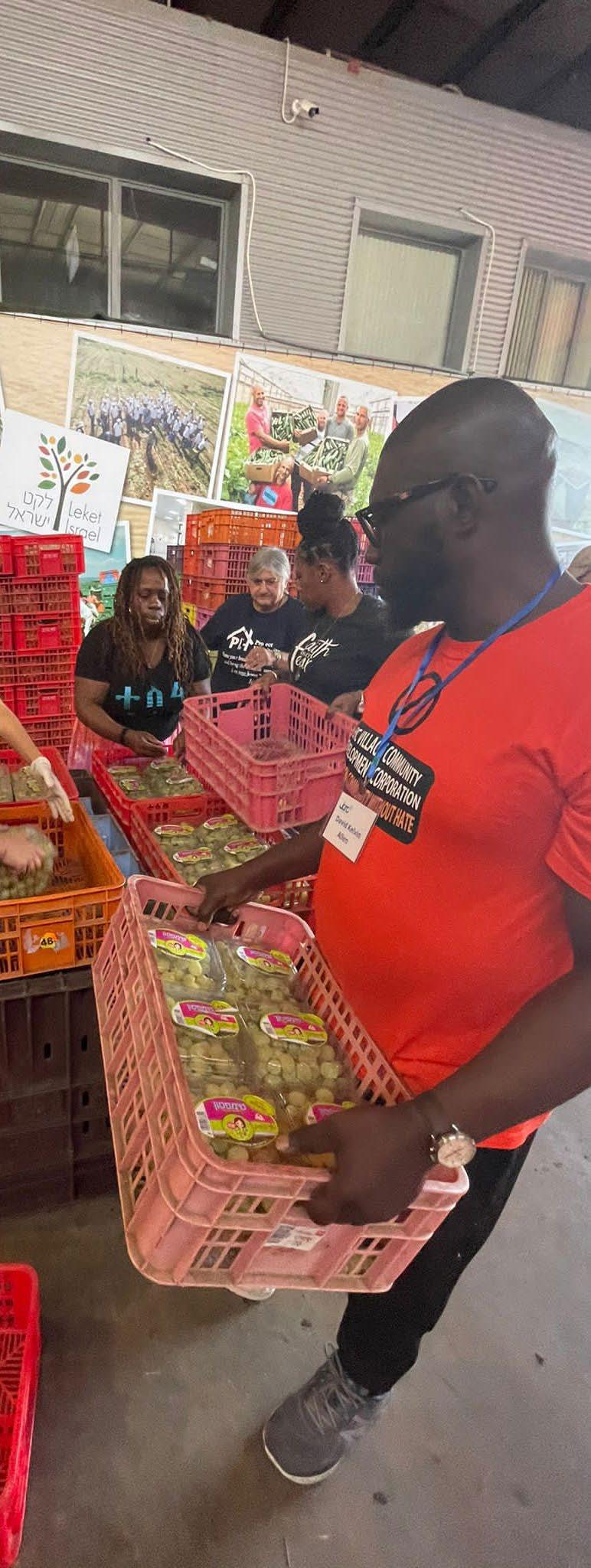 By Rabbi Bob Kaplan, Executive Director, Center for Shared Society, Jewish Community Relations Council of NY
By Rabbi Bob Kaplan, Executive Director, Center for Shared Society, Jewish Community Relations Council of NY
I’ve traveled to a number of places, but none had as direct an impact on me as Israel. Yes, every country has its own issues and probably its own mistakes that it’s recovering from. But if your view of Israel is only from what you read or see on CNN or Fox News, then perhaps I’d like to encourage you to see if your narrative will change by hearing, listening to, and seeing the narratives of so many different Jews. Thank you, Bob Kaplan and the Jewish Community Relations Council of New York for this lifetime memorable experience.
—Rev. Dr. David Allen, Epic Village Community Development Corporation
On September 11, 2022, a group of diverse community and faith leaders from across New York City boarded a flight to Israel. The group, many of whom had participated in one of the Jewish Community Relations Council of NY’s community-based coalitions or fellowships,
was leaving on the first Social Justice Study Tour conducted by JCRC-NY’s Center for Shared Society. The curriculum was designed to have these leaders interface and learn from organizations and individuals in Jerusalem, Tel Aviv, Lod, Ramle, Sderot, and Ramallah who navigate complex issues and narratives, such as trauma, resilience, violence, refugees, and asylum seekers—diversity and communal conflict challenges that they likewise navigate daily in their NYC communities. Throughout this experience, as Mitchel Wu from the Chinese-American Planning Council observed, participants truly opened their hearts and displayed empathy while listening to each and every story.
We started our journey with Daniel Hassan, executive director of the Jerusalem Intercultural Center. The group met with Palestinian women who have been leading a decade-long project called Mini-Action. Over time, the effort has grown to include over 2,000 women, each taking steps to ensure the quality of life in the municipality through MiniActions. They have transcended some of the stagnation of politics that has stifled interaction and a better quality of life for residents in East Jerusalem. As one of the participants put it, residents opened up about “their mental, physical, and emotional resistance to the
occupation.” This was our first brush with community-based, nontraditional leaders who, in the face of what is often designated as insurmountable odds, were navigating change.
The next day we met with Kuchinate, an organization that has been empowering women from the asylum-seeking African community in South Tel Aviv. We heard stories of an over 1,000-mile journey from Sudan (and other war zones in Africa) via a dangerous and often deadly passage through Egypt. Kuchinate has developed a series of wrap-around social services, from housing and health services to workplace development, offering an island of stability and hope.
It’s not only the stories but the experiencing of what survival looks like at the heart…resiliency. It’s real people who chose to live in a country despite being considered either as second-class citizens, refugees, or “angry displaced people.” However, in the midst of being displaced, being angry, not receiving benefits, unable to enter specific zones (B, C), the everyday survivors still believe in either the possibility of a one-state Israel or two states where everyone can fight and live on for their own endowment of peace. —Rev. Dr. David Allen
We had the privilege of eating at Battae, the Center for Ethiopian Israeli Heritage, an organization serving the Ethiopian Jewish community housed in a space that serves as an art museum, restaurant, and cultural center. The organization’s founder and chef, Ashagar Araro, greeted the group and told her story of the 2,000 years of the Ethiopian Jewish community, along with her family’s journey to Israel. The community, now in Israel for decades, answers a need to preserve Ethiopian Jewish culture within the complex diversity of the Jewish experience in Israel.
In Ramle and Lod, we met two powerful, yet soft-spoken women, Aliza and Yisca, who run the community mediation centers in these two mixed cities. They recounted, in a mixture of Hebrew and English, the whirlwind of violence and communal conflict they were thrust into in May of 2021. The mediation centers they lead are important places of community building, with opportunities for dialogue that have navigated local conflict without violence, building bridges across large, diverse populations of not only Jews and Arabs, but also immigrants and descendants of recent immigrants from Ethiopia, the former Soviet Union, Morocco, Iraq, Iran, and many other countries.
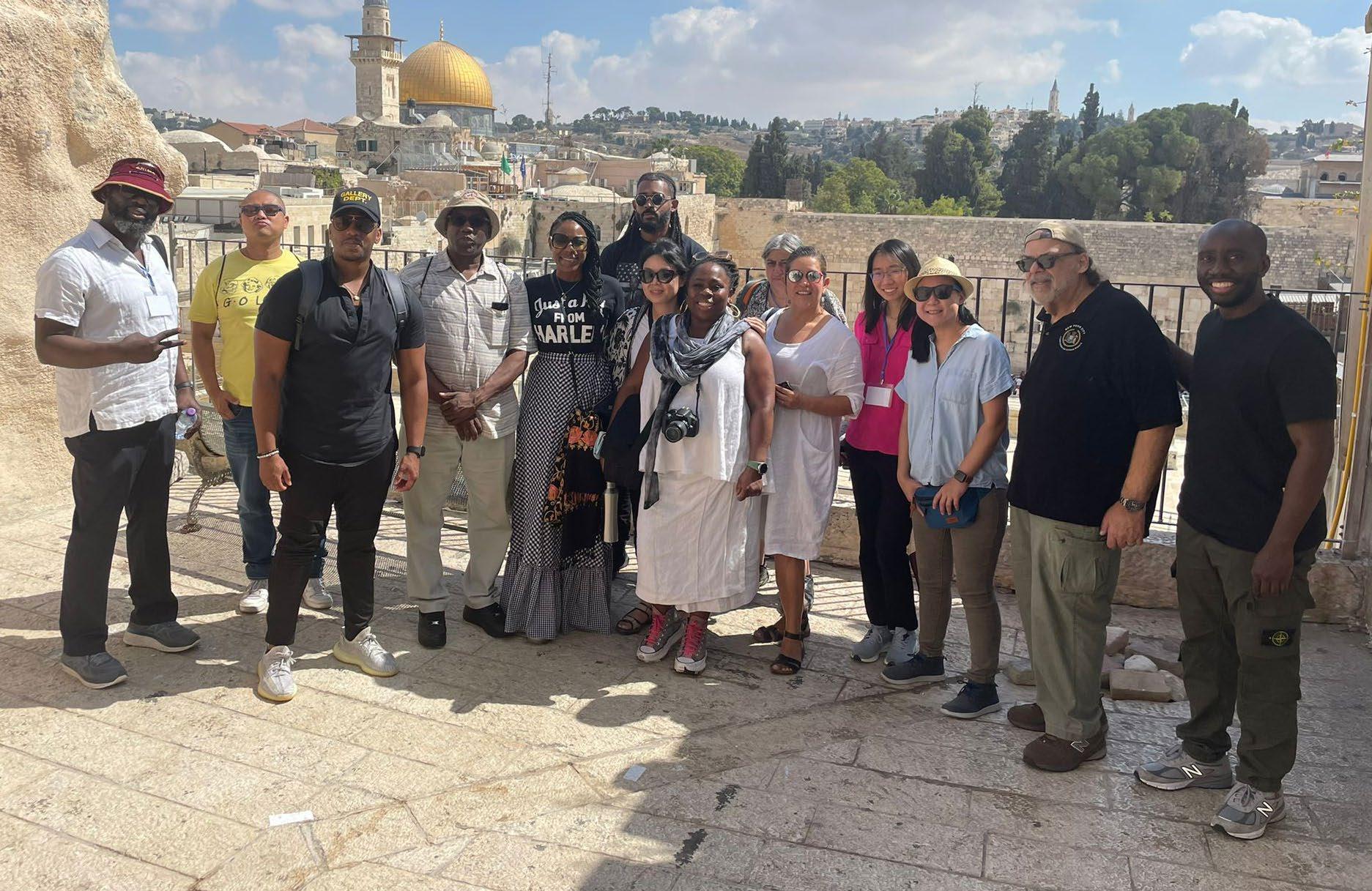
We then traveled to nearby Sderot, a city that sits on the border of Gaza, where a bomb shelter is located on every corner and in every house, school, and community space. The Israel Trauma Coalition (ITC) spoke about their work over the past two decades of meeting the trauma left in children and community members in the wake of violence. The ITC has also responded to international tragedies such as the earthquake in Haiti, Hurricane Katrina in New Orleans, Hurricane Sandy in NYC, and many more. The study tour group, after having experienced so many competing and compelling narratives over the past few days, took to this training in a very powerful way, seeking ways to bring it to their communities in New York.
Our next stop was Yad Vashem, the Israeli Holocaust museum, deeply touching all. We spent that evening in the home of Rina Quint, a 90-year-old survivor of the Holocaust. Our earlier experience in the museum came alive at a beautifully set Shabbat table where Rina told the story of her childhood in work and concentration camps; of the six mothers she had as a child, each playing an important role in the next stage of her journey through the Holocaust and traveling to the United States; of not knowing that she should cry at the death of her father because she saw death as normal. In her amazing and disarming way, Rina captured all our hearts. As we walked back through the quiet and empty Shabbat streets of Jerusalem, we knew we had been in the presence of a great and wise soul.
The journey ended with a visit to the Save a Child’s Heart program at the Wolfson Medical Center in Tel Aviv. For the past 40 years, this project has been bringing in children from across the world, from Zimbabwe to India, for heart operations that are not always available in their countries. They have likewise trained international doctors and care teams to lend support to these children in their own countries. This was an extremely powerful closing to this Social Justice Study Tour.
Throughout the study tour, participants could see that Israel is a complicated state with complex problems, similar to our own New York City. Many of the problems Israelis deal with must also be addressed here. So now, after a week of deep listening, it is up to our community leaders to turn what they learned into action. As Rev. Dr. David Allen put it, “The task at hand is to find the meaning of this trip and see how I can use the stories to change, build, renew, and reimagine a better Brooklyn due to this learning experience.” We know our leaders are “exploring synergies to improve the lives of all New Yorkers,” as Courtney Bennett, of One Hundred Black Men, said.
 DANCING AT BATTAE, THE CENTER FOR ETHIOPIAN ISRAELI HERITAGE
PHOTO: JCRC-NY
DANCING AT BATTAE, THE CENTER FOR ETHIOPIAN ISRAELI HERITAGE
PHOTO: JCRC-NY
ASSAF DEMONSTRATION ADVOCATING FOR THE RIGHTS OF ASYLUM SEEKERS
PHOTOS: ASSAF ARCHIVES
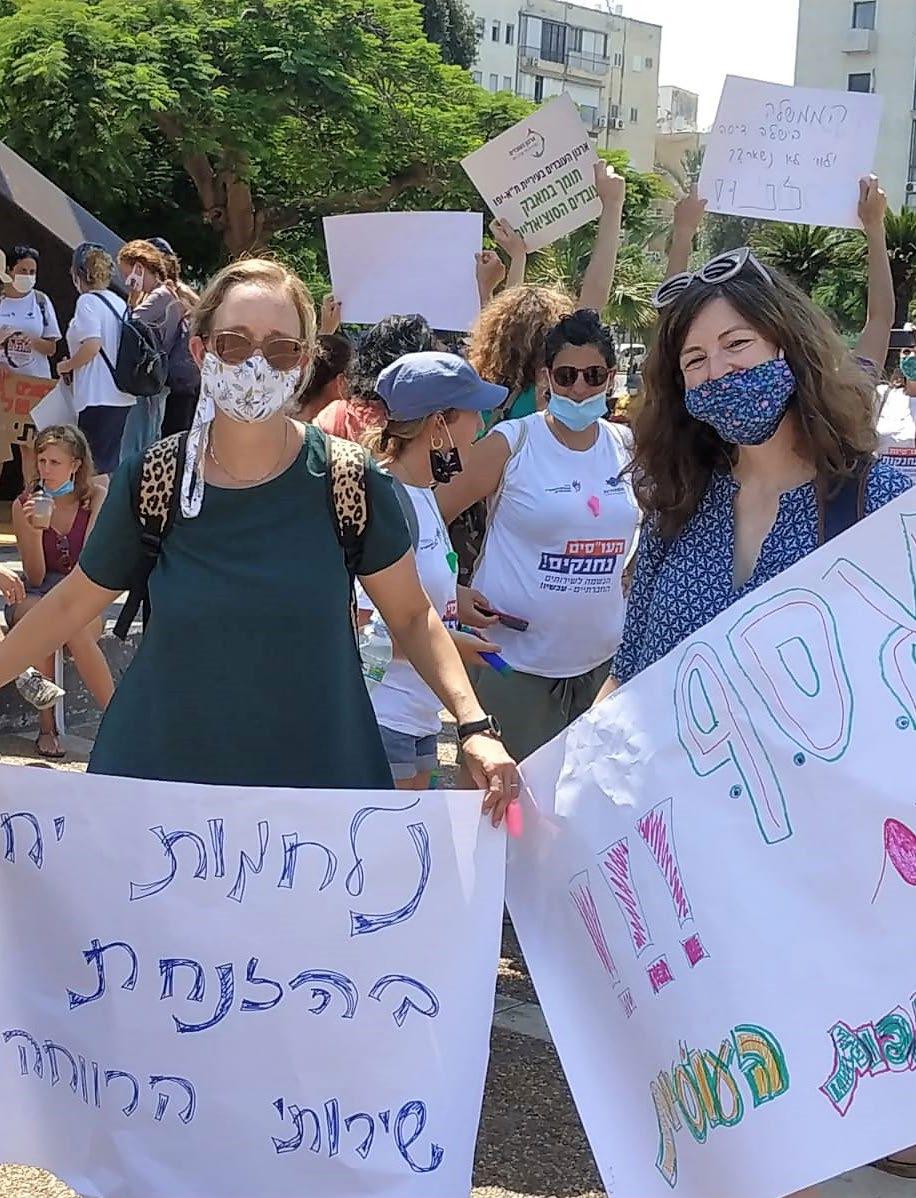
THE MANY FACES OF SOCIAL JUSTICE: A SMALL SAMPLING
By Rebecca Grossman, Program Director, The David H. Sonabend Center for IsraelIn our quest to understand social justice activity in Israel, the TAMUZ team decided to survey a variety of organizations working on this issue. The results are broad, and touch many areas and aspects of society. We asked each organization different questions, to better understand their work. Let’s take a look!
ASSAF
ASSAF is an aid organization for refugees and asylum seekers in Israel. Approximately 38,000 asylum seekers and children of asylum seekers are currently living in Israel, most from Eritrea and Sudan. Refugees and asylum seekers deal with daily realities stemming from the strife from which they escaped, coupled with the difficulties of life without legal status in a foreign country. This lack of status leaves them to survive without work permits, and denied access to health and social services. ASSAF, together with partner organizations, is also working to change the situation for Ukrainian refugees and expand their protection in Israel.
ASSAF is a nonprofit organization whose activities are based on donations and volunteering. The organization's staff consists of about 21 salaried employees and about 80 dedicated volunteers who are involved in various projects.
What are the most significant challenges asylum seekers face, and how does ASSAF assist them?
ASSAF is the leading human rights organization in Israel that protects and supports refugees out of a belief in the historical commitment of Israeli society towards refugees. ASSAF has been operating since 2007 on two main levels: providing psychosocial assistance and support to asylum seekers, and promoting the protection of this population’s rights by raising public awareness and promoting favorable policy change.
Support, care, and assistance to the community. Most
of those
who
turn to ASSAF come from the most vulnerable groups within the asylum seeker population: youth and minors, torture survivors, people with physical and mental
disabilities, the sick, the elderly, singleparent families, members of the LGBTQ+ community, and victims of gender-based violence. ASSAF runs various projects to support those who contact us, empower them, and make services accessible to them, including: community reception and the advocacy and support center, the youth club, survivors of torture support project, assistance for asylum seekers with disabilities, support for the vulnerable, humanitarian aid, and more. The methods of intervention are multi-systemic and include support calls and individual treatment, treatment of support groups, improving rights accessibility, humanitarian assistance, advocacy, and others.
Advocacy and policy change. Along with the direct assistance provided to refugees and asylum seekers, ASSAF works to change policy and promote rights for refugees and asylum seekers in front of government ministries, the Knesset, and local authorities. ASSAF publishes studies documenting what the asylum seeker community is currently experiencing, and writes programs and position papers promoting appropriate solutions and responses.
ASSAF believes that only through a combination of two levels of activity— psychosocial care and policy change—can the many obstacles that stand in the way of the refugees be overcome, bringing closer the day when they will be able to exercise their right to asylum.
Learn more about ASSAF here
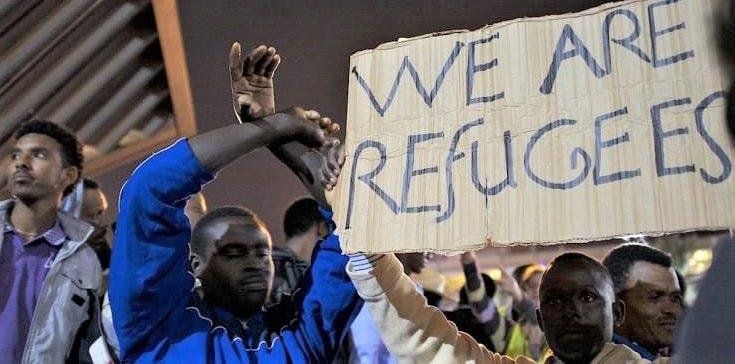
The Aguda
Established in 1975, The Aguda—The Association for LGBTQ Equality in Israel, acts as the umbrella organization of all Israeli LGBTQ organizations, grassroots movements, and communities that promote the welfare and rights of the LGBTQ community. Its mission is to achieve justice, equality, and inclusion for the LGBTQ community and to ensure LGBTQ visibility and affirmation. Over the years, The Aguda has guided alliance members to assist their capacity-building efforts and ability to work efficiently and with impact. It also works to create safe, inclusive, and affirmative environments for LGBTQ people by facilitating the development of local pride communities and providing direct services and supports that address a range of needs of the LGBTQ community in all its diversity throughout Israel.
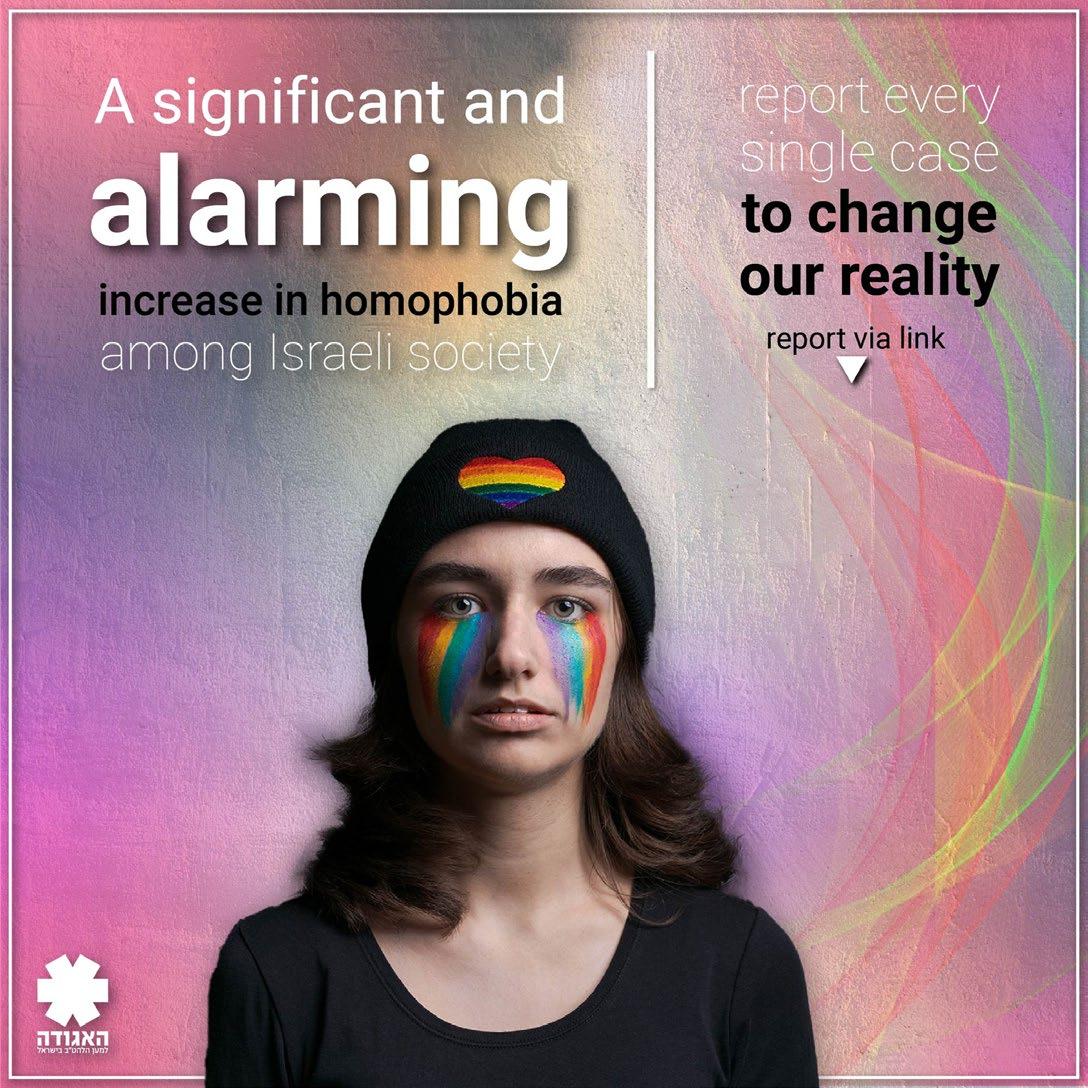
The Aguda also works on public awareness and lobbying, to prevent discriminatory legislation, policy, and budgeting, to mobilize and increase resources for LGBTQ organizations, and to tackle public ignorance, hate speech, and hate crimes based on sexual orientation and gender identity.
Who are some of the communities that are most in need? Do you need to tailor your approach to assist these communities?
In the past five years, The Aguda has expanded and tailored its programs and activities to support and change the social and legal landscape for marginalized sectors of our LGBTQ community, including:
Transgender community. In the past year, and in collaboration with trans organizations, The Aguda opened a Therapeutic and Advocacy Interdisciplinary Transgender Center. It is a physically safe space that strives, for the first time, to place transgender identity at the center, responding to the needs of the community, as indicated in existing research and experience, while integrating a holistic approach to transgender individuals. The center provides diverse professional activities, social support groups and social events, and leadership training and mentoring. The center is one of a kind in Israel.
Israeli Arabs. There are approximately 190,000 Israeli-Arab LGBTQ (based on the statistical estimate that 10 percent of the adult population identifies as LGBTQ). They mostly live in regions marked by conservative social views, underscored by a lack of access to LGBTQ-affirming resources. Furthermore, they are a national, religious, and ethnic minority and, as such, are subject to institutional discrimination. In 2020, The Aguda established Beit elMeem (in Arabic: a home for LGBTQ), a Safe Space for Arab LGBTQ to access culturally and linguistically-responsive support. The service encompasses an Arabic hotline providing anonymous, confidential, and free crisis counseling, information, and referrals; clinical social-work services in Tel Aviv and Haifa (one-on-one support); and legal aid. To encourage help-seeking, The Aguda conducts social media and digital outreach, thus raising awareness of the service.
Asylum seekers. LGBTQ refugees and asylum seekers are one of the most marginalized groups in Israeli society, particularly those originating from Africa and Palestinians from the West Bank. The LGBTQ Asylum-Seeker Program of The Aguda was created to meet this population’s unique needs in a safe and accepting environment, separate from the general services available to refugees and asylum seekers. The program was established five years ago and focuses on providing psychosocial support
to individuals, information and referrals to aid and legal organizations, information accessible to asylum seekers and the general public, and emergency financial assistance.
Learn more on The Aguda’s website, or check it out on Instagram and Facebook in English and Hebrew Yad Sarah
Yad Sarah is Israel’s largest volunteerstaffed organization, providing a wide array of compassionate health and home-care services for people of all ages, with special programs to support older adults and children or adults with disabilities.
Founded in 1976, Yad Sarah now has 122 branches throughout the country, staffed by more than 7,000 volunteers. Although the organization is best known for its extensive Lending Service for medical equipment—hundreds of thousands of items such as wheelchairs, crutches, and oxygen machines—its 7,000-plus volunteers also drive wheelchair accessible vans, taking the sick and injured to medical appointments. The professional staff and devoted volunteers also reach out to the homebound; advocate for elderly at risk for abuse; provide in-home geriatric dental care; staff a play center for children with special needs; help disabled people regain their independence through therapeutic programming at Day Rehabilitation Centers; staff an emergency
home alarm center with thousands of subscribers; provide free legal aid to thousands of at-risk elderly through the Yad Riva Legal Services program; offer afterschool programming and parental guidance for families with children with disabilities; extend therapeutic support for couples and families coping with domestic violence; and offer free dental care to older adults living in poverty. More than 800,000 people receive help from Yad Sarah annually.
What is the most challenging aspect of providing service to those in need?
Our biggest challenge is keeping Israel’s diverse population out of hospitals to avoid overwhelming the system, which means we need to ensure they have appropriate services to help them manage as independently as possible at home.
Yad Sarah recently inaugurated its 122nd branch, located in Be’er Ya’akov, at Shamir Assaf Harofeh Medical Center. The location of this branch enables families to prepare for hospital discharge by borrowing necessary equipment, helping alleviate the oftenoverwhelming responsibility of caring for an ill relative.
The organization also offers a mobile dental clinic, providing in-home professional care to the isolated and homebound all over Israel. This is a vital service. Older adults with mobility issues may be limited in their ability to leave their homes, yet face pain and discomfort, leading to negative health
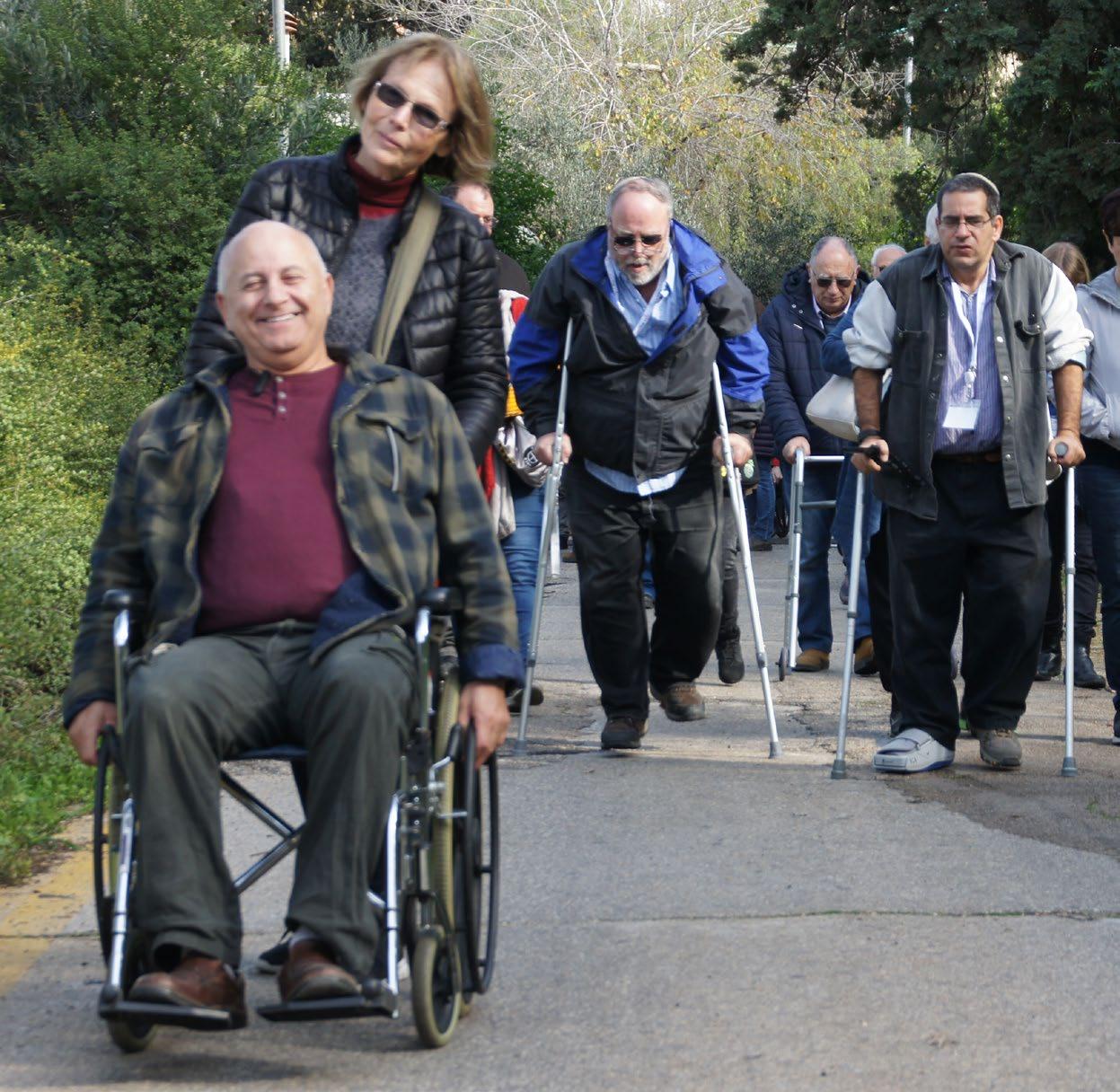
outcomes. It’s a challenge to identify these people. They are often frail, impoverished, and unseen.
Other services include installing an emergency alarm response system, enabling older adults to quickly summon help. Sometimes, the Home Hospital team will have concerns about the vulnerability of a person who is older or disabled who may be abused or exploited by a friend or a family member. Oftentimes, shame limits people from seeking the help they need and deserve.
At Yad Sarah, we work to identify and support those in need. Providing compassionate, individualized care to the people of Israel is the most important thing we do.
To learn more, visit Friends of Yad Sarah.
Home Base
Home Base was established in 2013, to empower the homeless community in Israel by helping individuals to transform their lives and become fully functioning members of society. Many homeless people once had jobs and residences, but their living situation may have changed rapidly due to a variety of social and economic factors: serious family breakdowns, abuse at home, job loss, and mental health problems or disabilities. Home Base’s smallest aim is to build trust and give them a positive outlet for their energy. Over time, it helps participants to believe in themselves and develop basic life skills that may have gotten lost on the street, linking them with community and health services and providing mentorship services.
Home Base developed a unique model, harnessing the power of team dynamics and group activities as therapeutic and rehabilitative tools. The sense of camaraderie and achievement felt in the team environment fosters a sense of belonging, raises self-esteem, and builds trust and responsibility. The organization’s projects include soccer teams for adults and at-risk youth, the Halalu women’s choir, locker projects, street medicine with a team of doctors and paramedics, Friday meals for volunteers and homeless people, and work with prisoners to shape them into effective members of society.
Benefits of team-oriented activities for the homeless include an increase in physical and mental health; education about
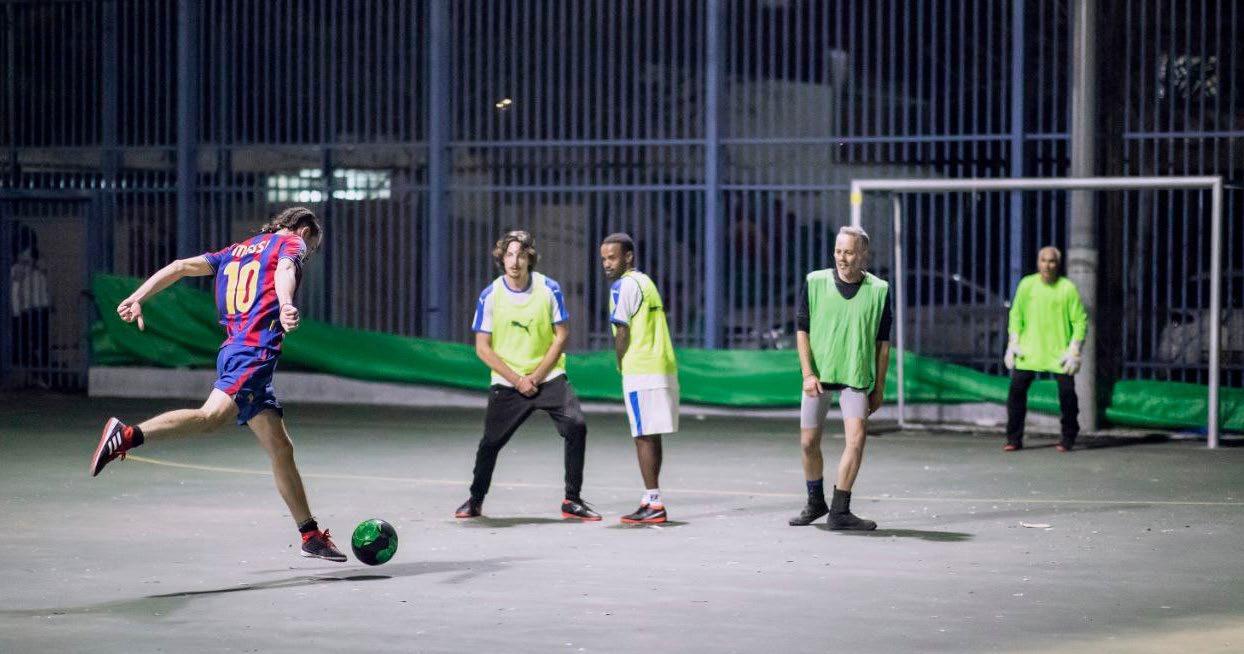
alcohol intake; decrease in drug use; team and relationship building; connections to social services, leading to the probability of receiving practical help; and location of stable, long-term housing and employment.
How did you build your program and attract participants with such a unique approach?
Home Base was created out of a desire to carry out a different type of “therapeutic” rehabilitation work with the homeless population, influenced by the “Homeless World Cup.” The idea was to use soccer as a therapeutic tool, one that enables direct contact with this sidelined population. The connection built serves both as a means and an end. Participation in the activity, and contact with the organization’s staff, is intended to be a significant part of the rehabilitation of the players and thus, their integration into society.
The model of our NGO is directly connected to the relationship between the staff, the

volunteers, and the participants. All our staff members and volunteers play soccer with the participants, allowing openness, intimacy and, above all, informal eye-to-eye contact. The relationship created enables participants to open up to the staff members and volunteers, who can thereby understand their needs and help them as much as possible. The relationship is also a goal in itself, because most of the participants are separated from support networks and from the community and find it very difficult to create and maintain connections. We began by meeting homeless people in the streets and at local shelters. We simply invited them to come and play soccer with us, in the same way we did in childhood. Meanwhile, we managed to build a working relationship with the homeless unit of the Tel Aviv social service department for referrals. Within a few weeks, our first team was formed and weekly practices had begun.
See Home Base in action, and learn more here.
IGY
IGY is Israel’s national LGBTQ+ youth organization, empowering thousands of participants between the ages of 12–23 to create a leading role for themselves in a more accepting society, while supporting their own understanding of sexual and/or gender identity.
Founded in 2002, IGY’s nationwide network of volunteers and activities supports the creation of safe spaces in an often homophobic culture. Its work extends to all
areas of Israel’s diverse society, including several support structures that focus on the unique needs of LGBTQ+ youth in Israel’s Orthodox Jewish, Arab, and Ethiopian heritage communities, respectively.
From its inception to the present day, IGY has been the only organization to work for LGBTQ+ youth in Israel. In recent years, it has grown to become the largest LGBTQ+ community organization in the country, with over 320 volunteers and over 4,000 youth members and participants taking part in activities throughout the year.

How has your work and the opportunities for your community changed over the past two decades? How has Israeli society shifted?
Israeli society has undergone multiple changes during the last two decades in terms of the mainstream attitude towards the LGBTQ+ community, many of them as a result of the local LGBTQ+ movement. From the country’s establishment until the late 1980s, being gay in Israel was illegal, and the LGBTQ+ organization had to operate under alternative names and deal with
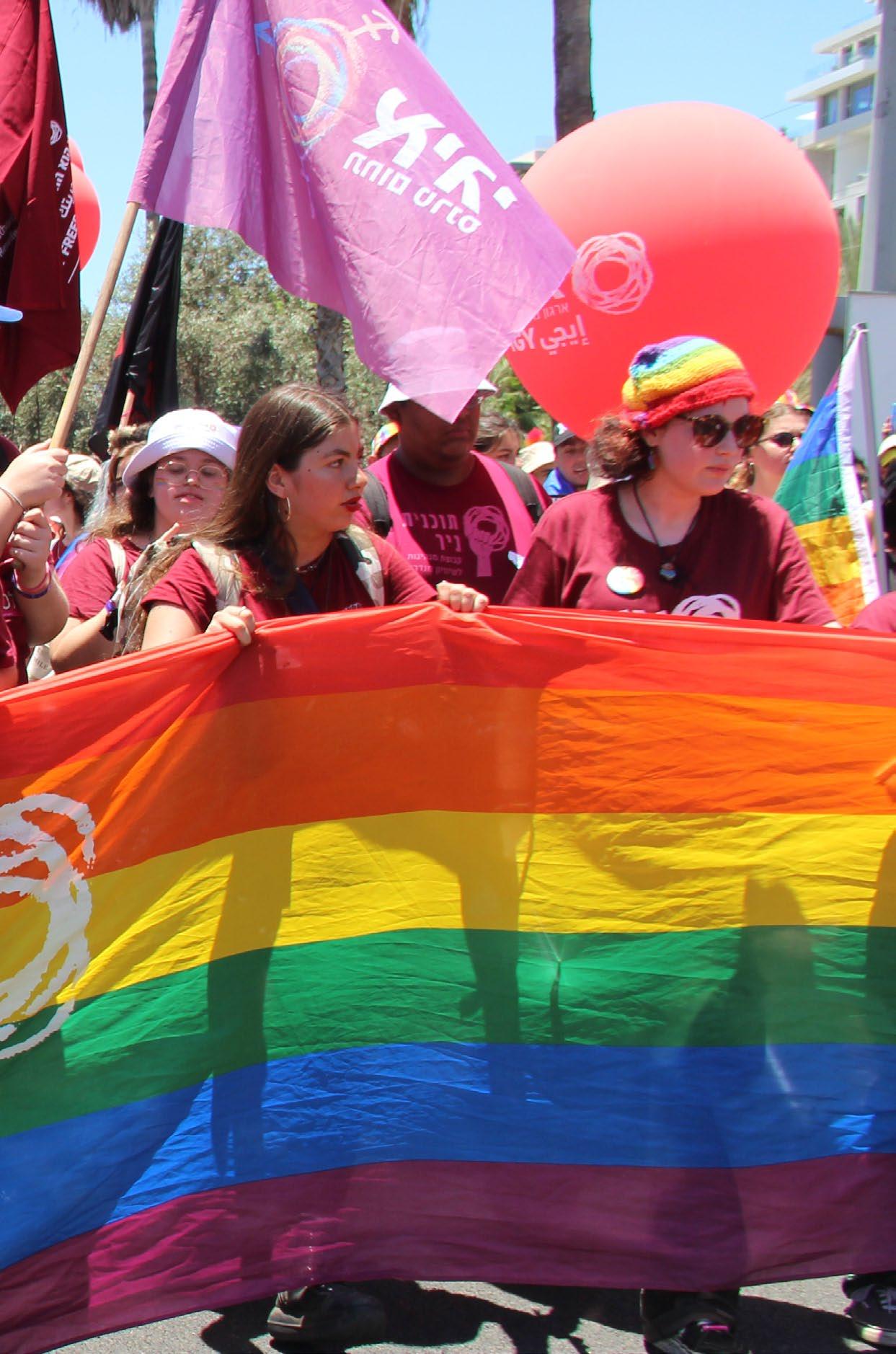
deep-rooted stigmas and unacceptance. It was only during the 1990s that Israeli leftwing Parliament members were able to decriminalize homosexual activity, cancel the ruling prohibiting LGBTQ+ soldiers from serving in the army, and thus allow the gay community to slowly find its way into mainstream public life.
Alongside legal progress the LGBTQ+ movement started fighting for its visibility through movies, TV, music, and culture.
Dana International’s (an Israeli transgender singer) win of the 1998 Eurovision song contest, along with a spontaneous protest against police treatment a few months later, led to the first Israeli Pride Parade in Tel Aviv. Although it might seem the Israeli LGBTQ+ movement has reached its main achievement, we see worrying backlashes from conservative public figures who are gaining strength in Israeli society, alongside many marginalized groups within the LGBTQ+ community (Orthodox, Arabs, transgender, and those on the geosocial periphery) who still suffer from violence, discrimination, and transparency. IGY has worked countrywide for the last 20 years to put a spotlight on the future of our community: LGBTQ+ youth and young adults, growing up all across the country, deserving a safe and equal society.
Learn more about IGY here.

MAKING A DIFFERENCE: A CONVERSATION WITH MIRIT SULEMA AND STAV SHAFFIR
By Rebecca Grossman, Program Director, The David H. Sonabend Center for IsraelIn today’s society, social change feels like an endeavor not worth undertaking. How can we really make a difference? To better understand how we can have an impact, I spoke with two incredible influencers, Mirit Sulema and Stav Shaffir.
Mirit Sulema is coordinator of the Dror Israel Urban Educators' Kibbutz in Akko. Stav Shaffir is a former member of the Knesset and founder of the Shira Center, a unique academy for young adults with autism and special needs. Both interviews, conducted separately, took place a week before the most recent Israeli elections.
My conversation with Stav Shaffir emphasized the need for universal activism in our systems. Our sense of empathy is key in building a movement to create change, which can then happen in a split second. We then must continue innovating on a local and more macro level. We must, as Mirit Sulema highlighted, constantly look around and ask “what is wrong, and what can I do to change it?” It’s like the story about saving one starfish, she said, “Saving just one doesn't do anything, but if everybody saves one starfish, we can help the entire shoreline
back into the ocean.” Local actions do matter in creating a shared society, and eventually, all together, we can help all the starfish on the beach return to the ocean. Even if we can’t help all of them, our efforts can make a difference for each one.
Rebecca Grossman: Mirit, I would love to delve a little bit into the work you do at Dror Israel. Can you tell me more? What inspires you to do the work you do?
Mirit Sulema: One of the most shaping experiences I had as a teenager was going to Poland. There we learned about the rabble on the Warsaw Ghetto uprising, and it was pretty mind-blowing to realize that young people can change the world. One of the things that I learned during that educational
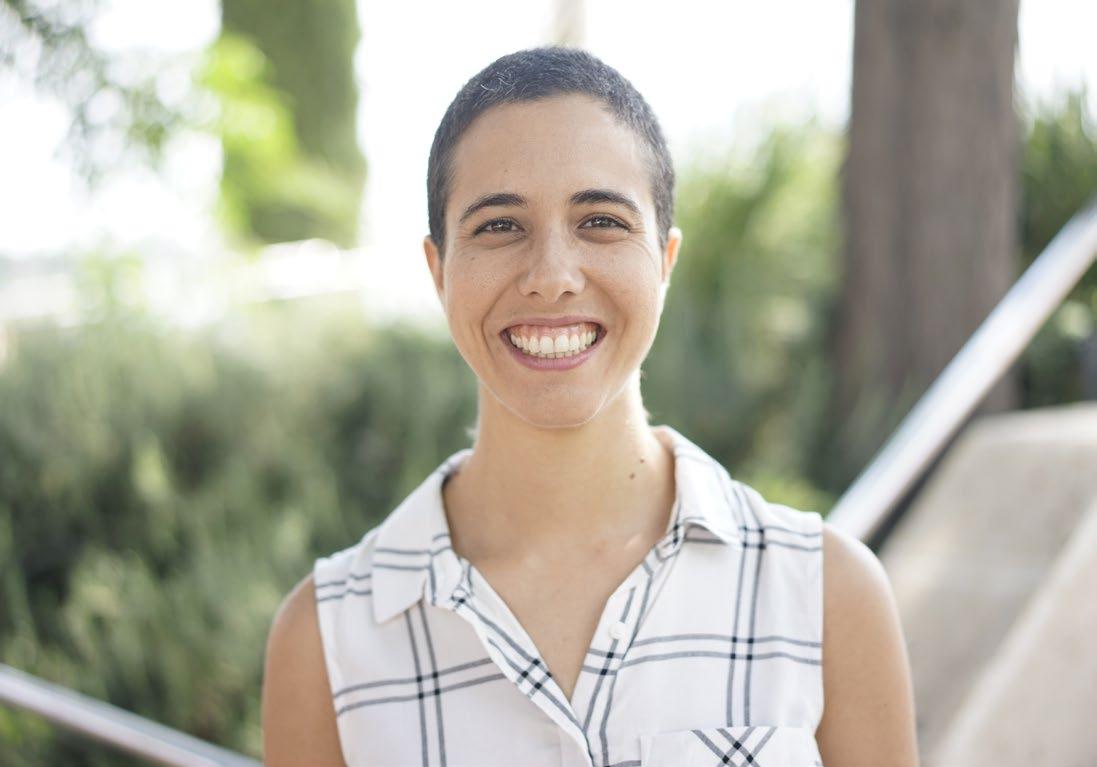
process is to ask myself, what do I see around me? What do I like about it? What do I not like about it, and what can I do to fix it or to change it?
In my gap year before the army, I was in Gedera, in a house in an Ethiopian-only neighborhood. It was the first time I ever interacted with Ethiopian Jews, racism and poverty, things that you should see, that you should know and be aware of, and it was very shaping for me to see the society around me, to see how diverse Israeli society is, and how we have the opportunity to make it an inclusive society.
These experiences led me to continue my work with Dror Israel. Dror is a grassroots, national organization that works all over Israel. We have 16 kibbutzim, or educators’ communities, which are spread all over the country, with between 60 and 100 educators.
We have a youth movement, Hanoar HaOved v’HaLomed, which translates to the federation of working and studying youth, working towards peace and collaboration between different sectors of society. The youth movement has about 100,000 participants all over Israel with all the different sectors of society, such as Jews, Christians, Muslims, Druze, Bedouins, Russian-speaking people, Ethiopian immigrants, and Israeli Arabs. We also have a network of high schools for youths at risk, and two boarding schools and a pre-army school, some of which also offer a variety of occupational training tracks.
Our educational projects address challenges in society. For instance, in Sderot, our kibbutz has partnered with the municipality to offer activities and projects in the shelters with the kids, helping them with their posttrauma. In Mitzpe Ramon, the educators of the kibbutz, with the residents of the city, started a co-op for groceries, as an alternative to the high prices of the singular grocery store.
About four years ago, in 2018, we purchased a building in one of the most challenged and underserved neighborhoods in Akko, called Janusz Korczak. The ground floor is somewhat like a cultural center, with all kinds of programs and initiatives for the whole community. Akko is Israel's most mixed city, with the percentages of the population being the closest between Jews and Arabs.

RG: It's incredible work that Dror Israel does and that you’re doing in Akko. Stav, can you tell me about the work you are doing now, and what inspires you?
Stav Shaffir: I can start by telling you what I'm doing these days. I left politics about two years ago. I ended up sacrificing my own seat in order to stimulate the collaboration between the other politicians, labor and those on the left, to ensure they remained in the Knesset. I took a break from politics, just when we were in the beginning of the first pandemic lockdown here in Israel.

A lot of things at the same time started to change. Israel was continuing to go through this democratic crisis. The people who are hurt the most from this lack of stability are those who are the weakest in society. One of them is my own sister, who has autism and development problems. She’s a very big motive in everything I do in life. People who lack basic independence need constant care, and the community, the country or our society, to help them, with the right institutions, to be able to access education, jobs, and help in life. When COVID began, many of the very few things that she did have in her life also disappeared because the systems stopped functioning.
I decided it’s about time that I do something, especially for her and for people like her. She always had that passion to be a student, even though she can't read or write. She wanted to go to university, but there's no
university that would accept her, and she can't go by herself.
So we decided to build one, called the Shira Center. It took us about a year to fundraise and build the first institution, and it was opened last March. It's inside a university. There are no fences or walls or anything that separate the special students from the neurotypical students. It's all open, but the special students get a special framework. They get education at the level that suits them. They get to work within the university facilities. They get a lot of help from volunteers in the university, and they have a whole therapeutic team that helps them in their day-to-day activities. The biggest thing is that they go to university feeling like real students, giving them an opportunity to feel meaningful in life. Now we're building more places like this. We have a huge demand, of course, because there's nothing. Everything you build is a spark of hope for so many people who can't find a place for their kids.
So I'm now working on building more places like that in other universities.
Sometimes I call our schools the empathy schools. The students with autism help teach empathy. By interacting with the students with autism, the students who go to the university for a regular degree get to learn what real sensitivity is.
That’s the biggest challenge of our society today. We’re losing that human value, the basis for everything. Sometimes we have empathy only for people from our own very close group. Empathy for others is the essence to have a democracy that is functioning and is the essence to have freedom.
RG: It’s incredible work that both of you do. It’s a steep endeavor to emphasize empathy and a shared society. I’m very curious, Stav, how were you able to get the support for this project, and beyond this project?
SS: The only way I know how to do things is by reaching out to the public and creating a movement around ideas. When we started the protest movements over a decade ago, we were a bunch of students who couldn't afford paying their rent. What we did was to move to live on the streets, to protest housing prices. The reason they succeeded and became a protest of a million people was because people joined. It was just a belief that something needs to be changed, along with a belief that in order for it to be changed, we have to take part. We have to physically be there.
When we started to build the Shira Center, my sister joined me and we started with a song to ask people to join her dream. When you come from real pain, you’re being very authentic and you are able to connect. It’s just about finding the right connection between your pain and somebody else’s pain and trying to reach out to solve it.

RG: It’s inspiring the amount of empowerment that you both have from your experiences and strength from your pain to then make that change that you see needs to happen in society. I’m curious if that leads into a larger theory of change, either from the grassroots or a more systemic level, or is it a mixture of the two?
MS: As a member of a youth movement, then as a member of Dror, I never felt like what I did was a little thing that I’m doing. I always met other people who do what I do in other places. So it’s a choice I made by myself to live the lifestyle that I live. If I do it in Akko with 80 other people, and someone is doing it in Ashkelon, someone in Sderot, someone in Carmiel and Haifa and Tel Aviv, in so many places, then it really feels like it has an impact.
So I can be involved in a very small-scale project, but knowing that Dror’s 1,500 educators are also involved in small-scale projects, all focused on a shared value of democracy and shared society, of peace and empowering others, then it's a lot of projects which can create a large impact, inspiring our students, and them carrying it to their society, their families, their workplaces, amongst their friends, in school, wherever. Sparking love in someone’s life can create a real change.
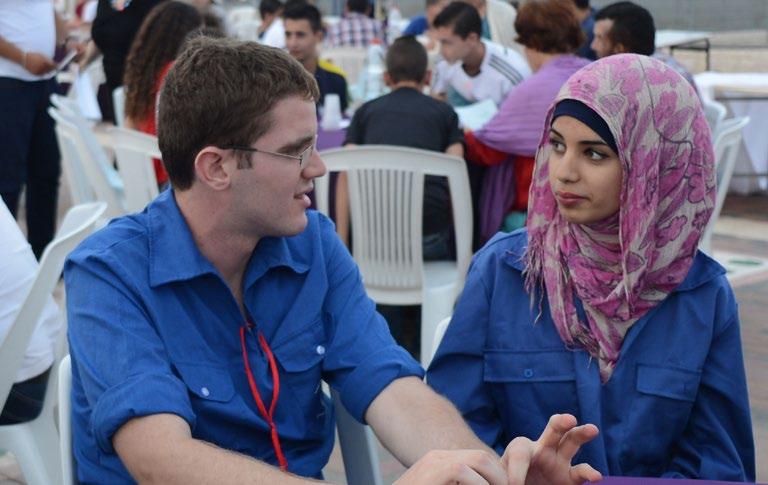
RG: I feel like that connects to Stav’s emphasis of empathy, really highlighting being able to recognize the humanity of the other and being vulnerable in that moment. I’m curious, Stav, how do you see a greater theory of change? Do you see that there is room for a change in the political system, or does change come from the grassroots up?
SS: I think we have to stop saying there is separation between these two systems. Politics is controlled by the people. It is controlled by what we do and how we act. If we organize, we can be efficient and effective politicians. Or create new ones to replace them. Voting is the least that you can do. The question is what you do next.
People expect much more from their democracies and democracies failed that hope, in a sense. We have to improve it and we have to constantly find new ways of doing it more efficiently. Closer to the people, to people’s streets and realities and basic services. And for that, people have to get more involved.
We need to activate people, so we need to look for ways to activate them, to make them feel that there is a reason to do it. Things can change in a minute, like what happened to us as students when it started, when we started to organize a protest movement. The minute of change comes like that, in a split second, but it comes after a lot of effort. There is no success story in politics or business that really succeeded in one attempt. You have to try and try and try and go through a lot of pain to see something really changed. But it will definitely not change if you won’t try.
What I’m trying to to do now, outside of my work at the Shira Center, is to collaborate with people from all around the world who are dealing with the future of democracy and try to figure out ways to do this new activism, to make citizens feel more empowered, to educate them about ways of making influence.
RG: The majority of the population does seem fairly silent and inactive, but that’s where the fruit of our efforts need to be put to create an active democracy across a variety of societies. Is there any area or handful of areas that you feel would activate the majority of people?
SS: I think a lot of it is about being closer to people’s basic needs. Sometimes politics and political discourse escapes that. It goes deep into theory and forgets about real, day-today lives. I’m a very strong believer also in
what we can do locally, like how we can be effective in everything that we do and how we can affect our own environment.
We have to make democracy interesting, full of imagination and creativity. We think about it for startups, but we don’t think about the most important startup in our life, which is how our very own lives, resources, and security are being controlled. We need to start integrating this system. The public, the street movement, life and politics, they are combined and always affect each other.
Israel, for example, has this genius startup industry with so much creativity and ability to solve the world’s biggest problems. I want to see the same minds trying to think about how we change our politics and how we change and improve our democracy. Even just for an hour a week. Everyone can find an hour a week to do something for their country.
RG: The reframing of the idea of innovation with regard to democracy will hopefully attract people who wouldn't typically want to be involved in politics and bring in some new and engaging ideas for our societies.
I’m curious, Mirit, how do you come up with new initiatives? It seems you and your fellow Dror educators are creating the innovative social changes that Stav is mentioning. How do you narrow in on the few things that are most important?
MS: Our dreams come from our educators, and I like to say that we are an organization for fulfilling dreams, usually on a very local basis. Some educator decides he has a passion towards something, he has a new idea, or sees something that he feels bad about and wants to address or tackle. And then they start an idea, and the financial team tries to help to get the funds for it. There’s a lot of new initiatives in a year. Maybe it will fail and we will learn from the failure. Maybe it will succeed, and we’ll learn from the success.
I think that youth movements are very inherent to the Israeli narrative and idea. Through a youth movement you can meet someone who’s different from you, just like I did when I met Ethiopian kids when I was working with the youth movement. I think it’s important for kids and youth in Israel to meet someone different from them with a counselor or guide, or with someone who gives them the tools to practice a good encounter. This is what we’re trying to do: get the kids, the youth, the elderly, the adults, to meet each other, and to collaborate and to think, how do we want Akko to look? How do we want Akko to be? And then work towards that. Once you collaborate with someone different than you, then you’re able to, and want to, try to picture a better world or a better city with them.
Then you’re automatically bound to the same belief; you understand that you’re tied. Your destiny is tied together. That is something we need more in Israeli society. More people meeting each other, seeing how they can collaborate and work together toward a better society, and not sectorizing and only taking care of themselves.
RG: Breaking down those boundaries between “us” and “them” and recognizing that we are all people is very powerful. We usually have very similar needs, desires, daily life struggles, and must recognize that we should be in a shared society helping each other, supporting each other, and we can all lift each other up. If we could bring that form of deep empathy and innovation to our daily lives and to our engagement with our political systems and societies, that could be really empowering.
Read the full interview with Stav Shaffir here.
Read the full interview with Mirit Sulema here.

CUISINE THE JEWISH FOOD SOCIETY TRACES AND PRESERVES CHERISHED TRADITIONS
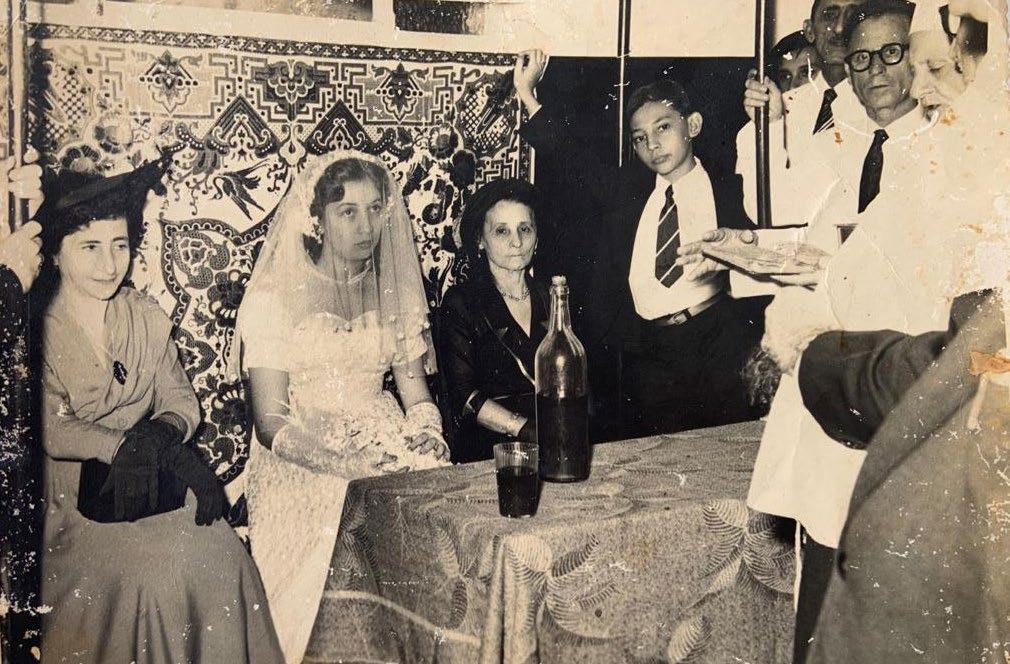
Growing up on a kibbutz in 1980s Israel, Jewish Food Society (JFS) founder Naama Shefi ate her meals with hundreds of others in a communal dining room. The food was simple and the menu repetitive, but from an early age Naama knew that she wanted more from food than sustenance. She would beg her parents to reserve one of the few communal cars so that the family could explore the country’s culinary diversity: from the rich flavor of lamb in the neighboring Arab town of Kfar Kassem, to the hearty soup in the Yemenite Quarter in Tel Aviv, and schmaltz herring in Petach Tikvah. For Naama, it was not just about trying new dishes, it was about connecting with people and cultures beyond the kibbutz. Food became a medium for identity exploration.
Join the JCC for a special event with the Jewish Food Society on February 1 as part of our Books That Changed My Life Festival. For more details, click here.
In 2008, Ilan, her now-husband, invited her to his grandmother Ketty Benatar’s home for Shabbat dinner. The table—covered in dishes like stuffed onions and tomatoes, Swiss chard pie, small pastries called borekitas, and much more—told the story of the family’s journey from Izmir, Turkey to Rhodes island in the Aegean Sea, to Rhodesia (present day Zimbabwe), and finally to Israel. Naama felt a strong sense of urgency to protect this culinary legacy and the stories that it tells. She didn’t know it at the time, but that evening planted the seeds for the Jewish Food Society.
Naama, who now calls New York City home, started JFS in 2017 as a nonprofit organization with the goal of preserving, revitalizing, and celebrating Jewish culinary heritage from around the world, so that recipes like those from her grandmotherin-law wouldn’t be lost to time. She and the entire team are guided by the belief that recipes tell the stories of how Jewish people live and love, how they celebrate and mourn; that recipes carry with them the marrow of who we are as individuals, as families, and as a people. They provide a concrete link to Jewish culture, identity, and community.
The heart of JFS’s work is the online archive: home to hundreds of family recipes and the stories behind them. Here, you can read about Stella Hanan Cohen, a cook in Zimbabwe who faithfully maintains 500-year-old Sephardic recipes, or Olga Sternberg, who found sustenance in recipes
shared orally among prisoners in Auschwitz. You can read Esther Weyl’s story, tracing her Brazilian community’s Moroccan roots through its recipes, and recreate them.
JFS brings the archive to life through Shabbat dinners, cooking workshops, and one-of-a-kind events. Its flagship event, Schmaltzy, features live, food-related personal tales followed by a tasting of the dishes highlighted in the stories. During the COVID-19 pandemic, JFS launched a podcast by the same name, sharing the best stories from these live events.
In 2021, JFS welcomed a new sister organization in Tel Aviv, Asif: Culinary Institute of Israel. A collaboration with Startup Nation Central, Asif features a culinary library, gallery, test kitchen, rooftop vertical farm, cafe, and local provisions store. It serves as a research and development center to explore the various influences that contribute to Israeli cuisine and showcases Israeli culinary innovation. In celebration of its one-year anniversary, Asif published a special journal with recipes and highlights from its first year of activity.
JFS believes that once the plates have been cleared, the stories and memories should live on, connecting us to past experiences and inspiring future generations.
If you have a special family recipe and story to share, JFS would love to hear from you!
AMORONIA (BAKED CHICKEN AND EGGPLANT)
Esther Serruya Weyl contributed this recipe, of Turkish origin, to the JFS recipe archive as part of her research into Jewish culinary traditions brought to Brazil.
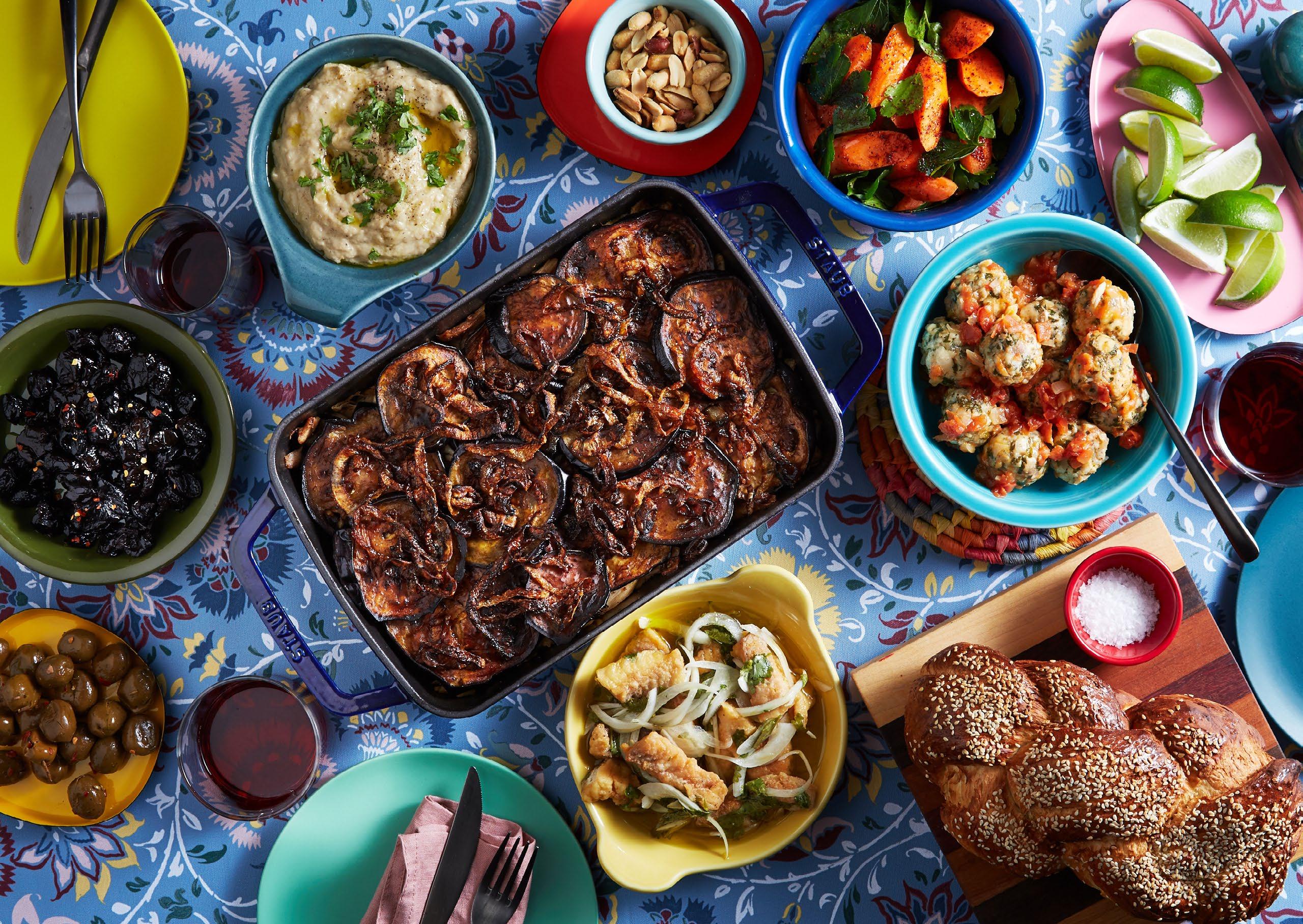
Ingredients
1 pound chicken thighs , skin-on, bone-in
2 tbsp. plus 1 tsp. kosher salt , divided
1 large eggplant, cut crosswise into ¼-inch slices
⅓ cup plus 2 tbsp. olive oil, divided
2 yellow onions, thinly sliced
¼ cup honey
¼ tsp. ground cumin
¼ tsp. ground nutmeg
¼ tsp. ground cinnamon
¼ tsp. ground black pepper
Preparation
Preheat oven to 430 degrees.
Prepare the chicken: season each chicken thigh with about ½ teaspoon of salt, and a pinch of pepper. Make sure to season all sides of the chicken. Place on a baking sheet, skin side up, and roast in the oven for about 50 minutes, until the chicken is golden brown, with an internal temperature of 165 degrees. Remove from the oven and set aside to cool for about 15 minutes.
Reduce oven temperature to 400 degrees.
Meanwhile, fry the eggplant: Place the eggplant slices on a wire rack and sprinkle all the pieces with salt on both sides, about 1 tablespoon of salt in total. Set the eggplant aside for about 30 minutes. Pat the eggplant slices dry with a paper towel. Place ⅓ cup olive oil in a large saucepan over medium to high heat. Once the oil is hot, carefully place about 4 slices into the pan. Fry the eggplants until deep golden brown on each side, about 5 to 7 minutes for each side. Transfer fried eggplant to a paper towel-lined baking sheet to drain any excess oil. Continue frying the rest of the eggplants in batches, adding more oil if needed and adjusting the heat if necessary. Set aside.
Saute the onions: Place a large saucepan over medium to high heat. Add 2 tablespoons of olive oil to the pan and allow the oil to heat up. Add the onion slices into the pan and cook until they are soft and brown, stirring occasionally, about 15 minutes. Add 1 teaspoon of salt and the honey into the pan, stir into the onions until combined, and turn off the heat. Set aside.
Shred the chicken: Once the chicken is cool enough to handle, shred all the meat off the bone, using two forks, into bite-sized pieces. Discard the chicken bones and any cartilage. Place the shredded chicken into a medium bowl. Add cumin, nutmeg, cinnamon, ½ teaspoon salt, and mix well to combine. Set aside.
Assemble the Amoronia: Place about 5 of the eggplant slices into the bottom of a 7.5 x 5.5inch baking dish, in one layer. Layer half of the shredded chicken over the eggplant. Spread ¾ of the onions over the chicken. Add the remaining chicken over the onion and top it with a layer of the remaining eggplant slices. Sprinkle the rest of the sautéed onions on top. Bake uncovered for about 30 minutes.
Serve hot.
MERINGUE WITH ORANGE MARMALADE
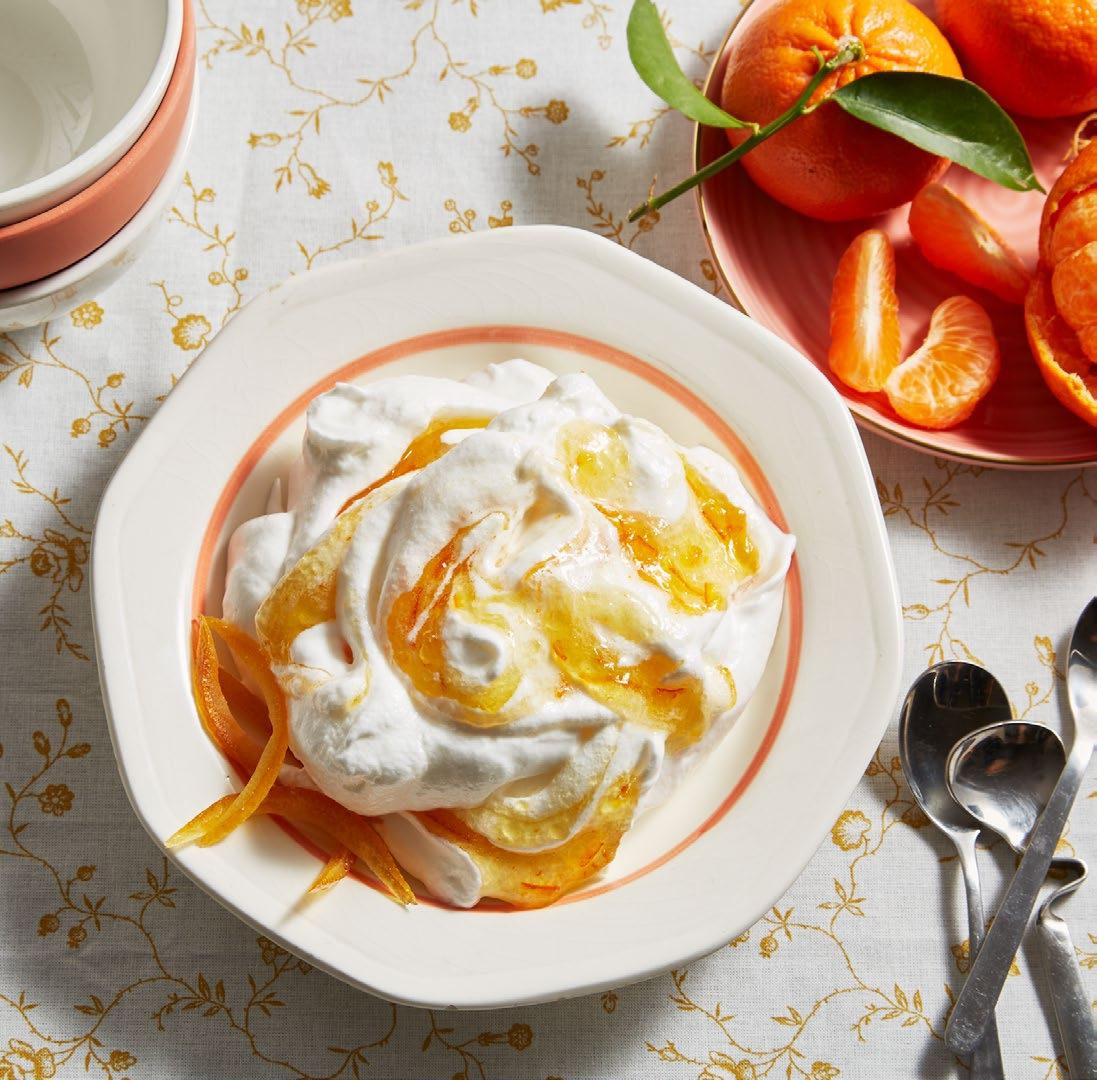
Esther Serruya Weyl also contributed this recipe that in Brazil is flavored with the tropical fruit cupuaçu, described as having notes of chocolate, melon, and pineapple.
Ingredients
4 egg whites
1 cup sugar
½ cup water
4 tbsp. orange marmalade
Preparation
Whip the egg whites to soft peaks in a stand mixer.
Place the sugar and water in a pot over medium-high heat. Dissolve and cook the mixture until it reads 240 degrees on a thermometer.
Photography
Penny De Los Santos
Food Stylist
Judy Haubert
Courtesy of
Jewish Food Society
With the mixer on medium speed, slowly drizzle the hot sugar mixture into the egg whites. Continue mixing until the meringue reaches stiff peaks.
Transfer the meringue to a large bowl and add 2 tablespoons of the marmalade. Fold the marmalade into the meringue a few times to create orange streaks. Place the mixture into a large serving bowl and top with the remaining 2 tablespoons of marmalade.
Seal the meringue with plastic wrap and refrigerate for 1 to 2 hours. Serve cold.

DESIGN
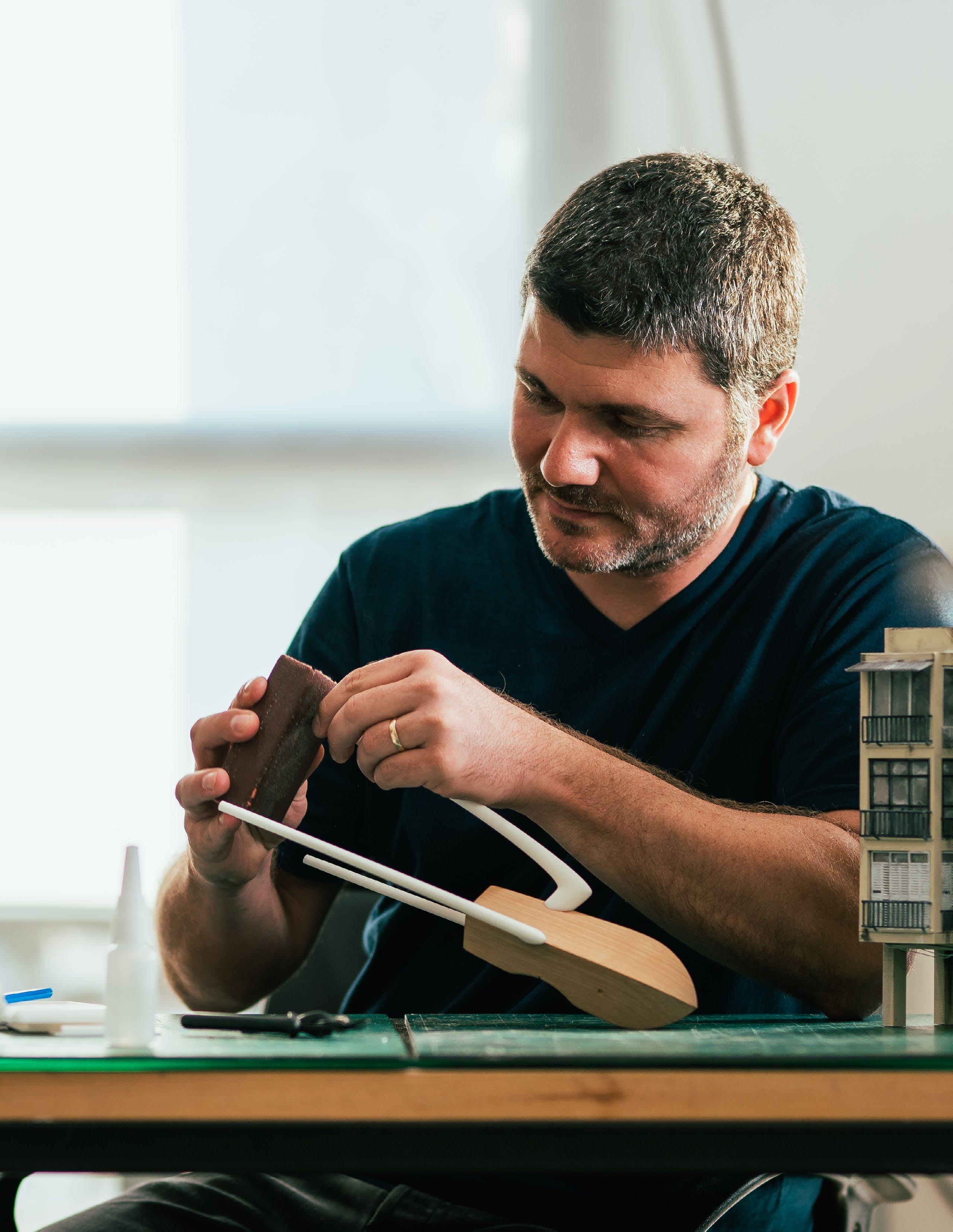
SHAUL COHEN BRINGS EMOTION TO 3D-PRINTED WORKS

For many, 3D printing is still hard to understand, something that might be too futuristic. But in the hands of Israeli industrial designer and artist Shaul Cohen, co-owner of 3D Factory, the medium says nothing about the future. On the contrary, his creations are filled with nostalgia for the small moments in life.
Among his whimsical creations are Bauhaus Rings made with rocks from real Bauhaus buildings in Tel Aviv; Pillow IDF, an inflatable soldier’s beret, to make a quick nap much more comfortable; and Balata, a floor tileshaped piggy bank, for those who like to hide money in the floor.
However, he is best known for his Life in Snow Bubble series and Mini Buildings. Life in Snow Bubble presents nostalgic but very real elements of the Israeli landscape in a snow globe, without the snow. These are not your typical tourist snow globes. Instead of the Western Wall or Israel Museum, you will find a lottery kiosk, a bus stop, a beach lifeguard tower, and a street recycling garbage can. The globes are a picture-perfect view of Israel—colorful, but messy; beautiful, but aggressive.
For his Mini Buildings, Shaul creates models of real buildings in Israel using a 3D printer, but then hand paints them, adding humorous touches. The pieces are so uncannily accurate that it’s hard to believe they are not photo images of the originals. Shaul also accepts custom orders for models of childhood homes, first apartments purchased, and other buildings that hold special memories—sometimes good, sometimes bad, but always nostalgic.

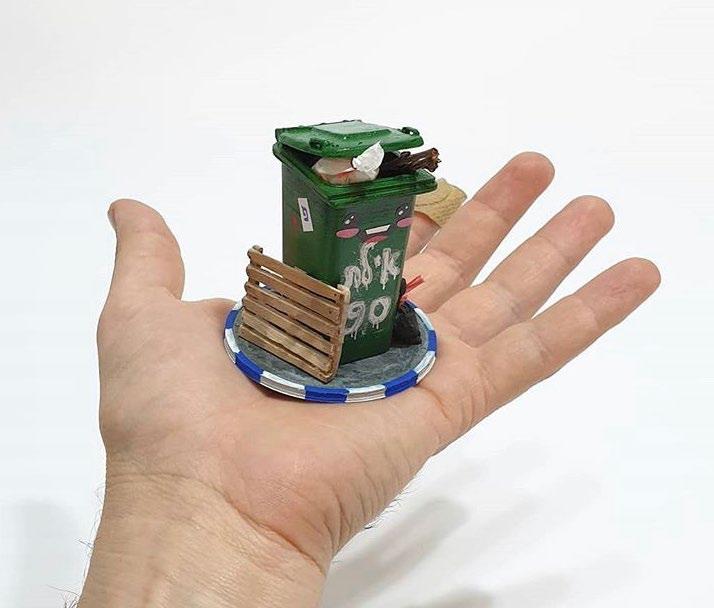

Perhaps his most significant accomplishment is how Shaul uses a 3D printer to conjure powerful sentiments. His works can make you smile, for sure, like a feel-good movie, but they also take you on a journey—to your first home, to the smell of garbage cans on your old street, to the candy store at the end of the block—and that’s priceless. Shaul creates pieces that, although reflecting Israel, touch hearts around on the globe. And that is where art and design, when done right, can be magical.
To learn more about Shaul Cohen, check out his Instagram, or visit his website: shaulcohen.com.


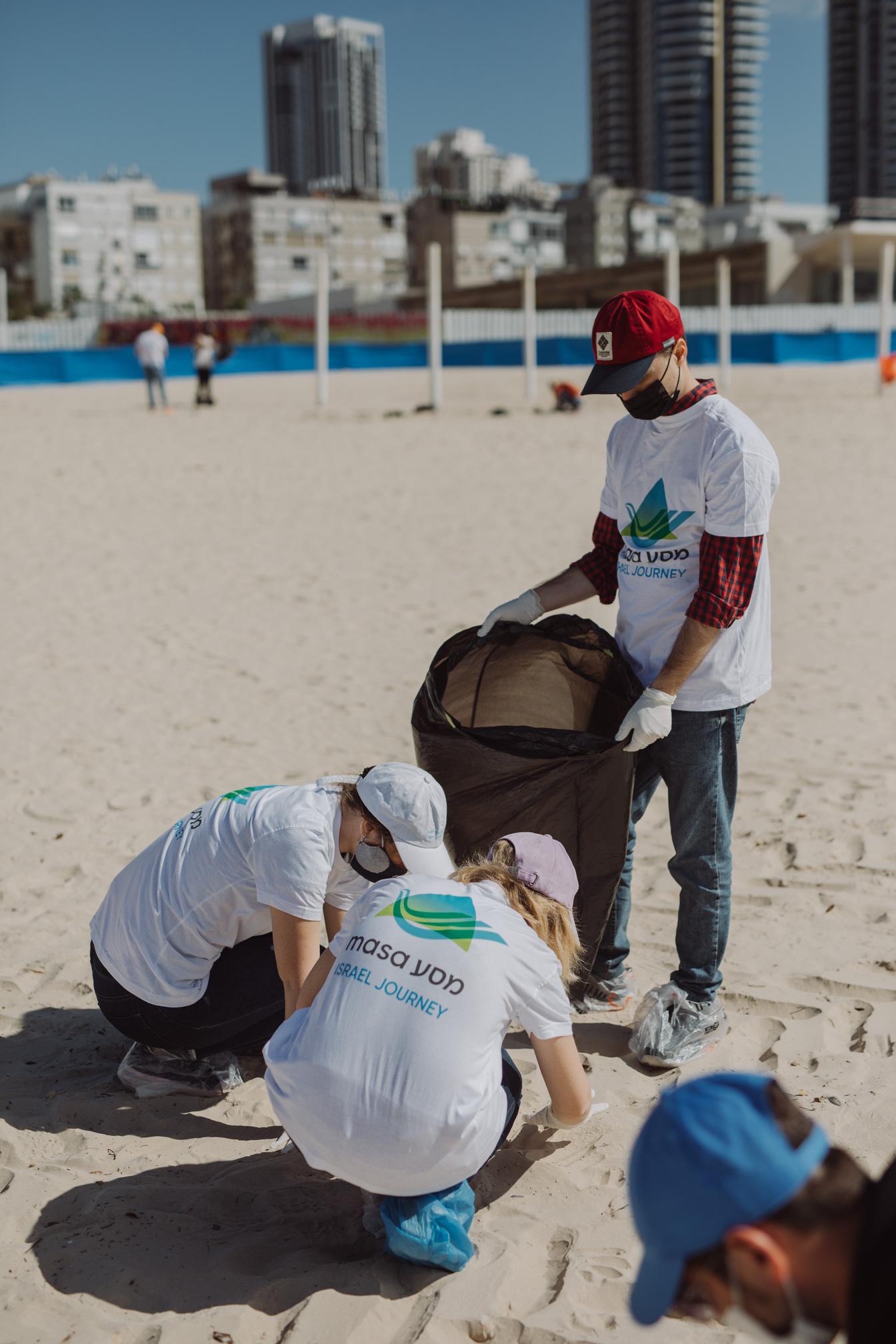



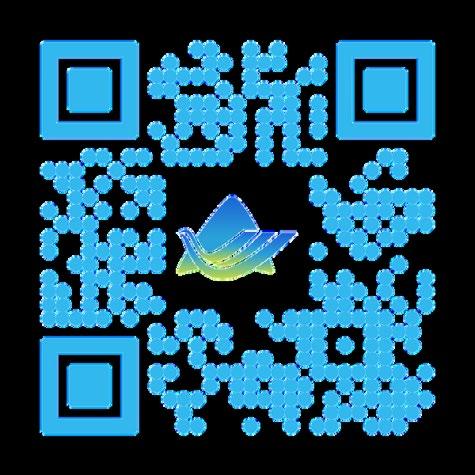

INSPIRATIONAL ISRAELI
SAMAH SALAIME

Samah Salaime is a member of Wahat al-Salam Neve Shalom, a social worker, community activist, and feminist. In 2009, following a wave of killings of women in the central cities of Israel, Samah established Na'am—Association for Arab Women in the Center, a nonprofit promoting the status of Arab women in Ramle, Lod, and Jaffa through social and holistic services and solutions. The association acts for girls and women who are victims of violence and oppression in society in general, and in Arab society in particular. Samah was chosen by the Israeli newspaper Yediot Achronot as one of the 10 most influential social activists in Israel. She graduated from Hebrew University with bachelor’s and master’s degrees in social work and is a graduate of the Mandel School for Educational Leadership.
What is your favorite part of the day?
I love the nighttime. I like the late night, after a long day of work, housework, and being with my kids. I start to feel myself, to go over the day that’s ending and ask myself what was good or less good. My mind starts looking forward to the upcoming day and what I can do with it. Those are the hours I can let myself swipe through social media, write a silly post or a serious one on Facebook. And usually it is in the small hours, when I’m alone with my thoughts and feelings, that my weekly article starts taking shape.
If you could meet with any famous figure, living or dead, who would it be?
I would really like to meet Angela Davis, who is now 78. Angela represents for me the utmost values that have guided me in my public, professional, and personal life. She spoke of the intersectional nature of the struggles of women and the black minority long before the world knew about double oppression.
I am a Palestinian, feminist citizen of Israel who sees the complexity Davis speaks about. Today, I understand the connection between gender oppression in a patriarchal society and the militaristic oppression of Palestinians living under Israeli occupation.
I must seek my partners-in-struggle from among the Jews, my fellows and friends who believe in democracy and equality and who desire peace. Angela, to me, is a model of holistic feminist activism who for years struggled for justice and freedom for all people. I know she and I would have a lot to talk about.
What has been the most challenging time in your life, and why?
The last two years, if the truth be told, have been immensely challenging. Today I am 47 years old, and not long ago I made the decision to put an end to my relationship of 25 years. That is, to file for divorce. Sometimes I think it is too late for such things, but I had reached a point at which I couldn’t believe in my own self-worth, continue struggling for the rights of Arab women and demonstrate against genderbased violence, or appear in the media and write about gender-based oppression when I did not have support at home from someone who shared these values.
That young woman of 20 who married her sweetheart grew into a well-educated, hard-working woman who has a respectable record of feminist struggle. But I found myself living with a man who did not support me or value me and even jeered and belittled what I was doing with my life. It was as if I were living two parallel lives, and I had to choose one—one that fit my personal truth. I am a feminist, writer, activist, and believer in shared society and peace. Any partner I choose must understand and love that about me.
What is one of your proudest moments?
In the winter of 2008, I got a phone call from New York, from the organization Echoing Green. This is an amazing organization that supports social initiatives around the world. They informed me that I was invited to New York (for the first time in my life) to present to them the organization I dreamed of establishing. I had 90 seconds to talk about that dream before an audience of hundreds. I was afraid; I was shaking, and I had left my eight-month-old infant at home. I spoke about the organization that would be known as Na’am, a feminist group that would serve women in a holistic way in Israel’s mixed cities and would fight to end gender-based violence. I came home from that journey and, with that certificate in front of me, I got my first grant that led to me realizing my dream. Our struggle to prevent femicide is still far from over, but that was a moment of pride for myself and for the women who had sent me. I felt we had managed to break a glass ceiling above the heads of Arab women.
What is your favorite Israeli dish?
They say there is no such thing as an “Israeli” dish. Israel is a mosaic of people, cultures, and food. Each group has its traditions and its food, and it is no secret that Middle Eastern Arabs know how to enjoy and to prepare great meals. My Jewish friends love to eat my Palestinian food—food that was eaten here before 1948 and is still prepared today. In particular, we all love stuffed grape
leaves, and I have even begun to make a vegan, kosher version that I introduced to the peace movement.
What is your favorite location within Israel, and why?
I love the place where I live. It is called Wahat al-Salam Neve Shalom, and it is an intentionally mixed Arab-Jewish village. It is the place where I work and raise my children. The state does not support it, and it does not dare to build other shared spaces like this in which Arabs and Jews can choose to live together in peace. I am proud of my village and of the fact that it has supporters all over the world. It is an egalitarian community of peace lovers who raise their children together, and teach them in Arabic and Hebrew (and English). My village is a model that proves it is possible to make real peace between the two people, while also showing the hard work it takes to preserve that peace.
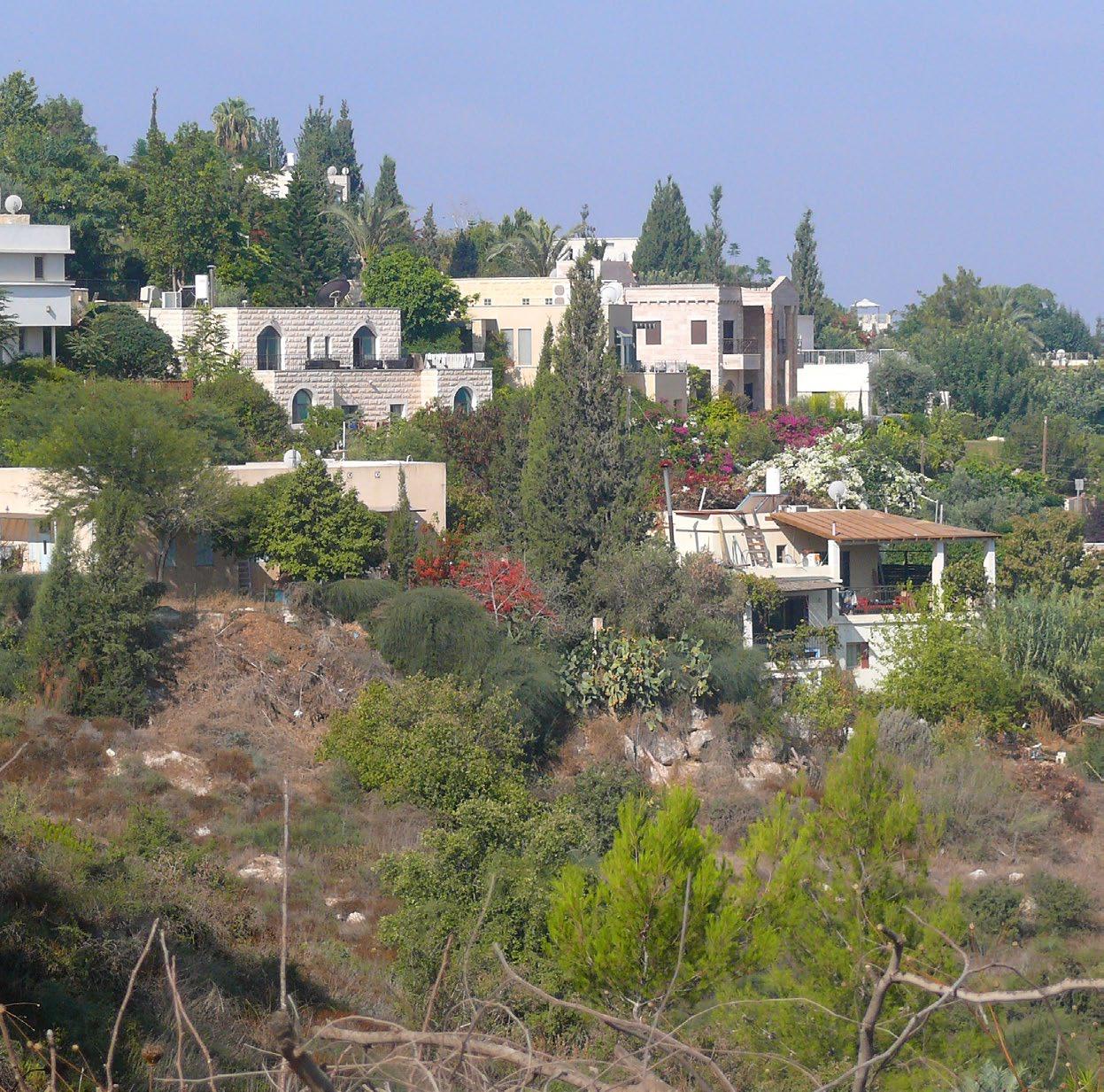
Who is an inspiration for you?
There are many women and men who inspire me, but in the past few years I have come to like Michelle Obama, New Zealand Prime Minister Jacinda Ardern, and the former German Chancellor Angela Merkel. The latter served her country for 16 years running, and moved that country forward. She knew how to balance managing an economic, political, and information superpower with making unpopular decisions, including humanitarian ones during the Syrian civil war. My extended family includes Palestinian refugees who have lived in Syria since 1948, and they were openly welcomed in Germany after having lost everything for the second time, getting another chance to begin anew. Merkel is an example of one who led in a feminist, democratic manner in this world, without missiles or a strong military, and with intelligence and sensitivity.
What advice would you give a young person who wants to change the world?
Be the change you want to bring to the world, the change in daily life. If it is a change the world needs, others will follow you.
What is your biggest fear?
These days I fear people with racist, strongarm ideology who are gaining power in our governments and in our world. This racism is unfettered and dangerous. Most people do
not want to fight or hurt one another; they want democracy and peace, but they do not do enough to protect it from the extremists.
If you could change one thing about Israel, what would it be?
I would change a lot of things about Israel. If I had to pick one, I would change the “nation-state law,” a law that discriminates against Arab citizens of the state, and degrades their status and their basic rights as a national minority. This law enables crude discrimination against any non-Jew, including preventing self-determination, the right to live and build a house in the same way as a Jew, and even gives the Arabic language second-rate status. It is a law created with the sole purpose of giving Jews the highest status and making Arabs second-class citizens, and it leads to hatred, resistance, and violence. At the minimum, I would like to see this law repealed.
What cause are you most passionate about?
I am passionate about the struggle for peace, shared society, and ending the violent occupation of the Palestinian territories. These are connected with my second passion: the rights of women around the world and of Arab women here.
Click here to read more about Na’am.
TRAIL OF ISRAEL

A VIRTUAL WALK
Part three of a six-part series highlighting different paths along the Israel National Trail. The Sonabend Center for Israel presents Trail of Israel—A Virtual Walk. The series focuses on discovering all aspects of life and communities in Israel, such as the Orthodox, the Druze, technology hubs, kibbutzim, and a view of Israelis living their everyday lives.
In this and subsequent issues of TAMUZ, we will share small parts of our trip along the trail. Let this be your inspiration to visit the trail, or parts of it, during your next visit to Israel.
In this clip, we visit Latrun, which is located at a strategic hilltop in the Latrun salient in the Ayalon Valley. It overlooks the road between Tel Aviv and Jerusalem, 25 kilometers west of Jerusalem and 14 kilometers southeast of Ramle. It was the site of fierce fighting during the 1948 war. From 1948 to 1967, Jordan occupied it at the edge of a no man's land between the armistice lines known as the Latrun salient. In the 1967 war, it was occupied by Israel. Since then, it’s become a land of many tourist attractions, forests, and communities that have filled the area with a variety of cultural, culinary, and artistic vibes.
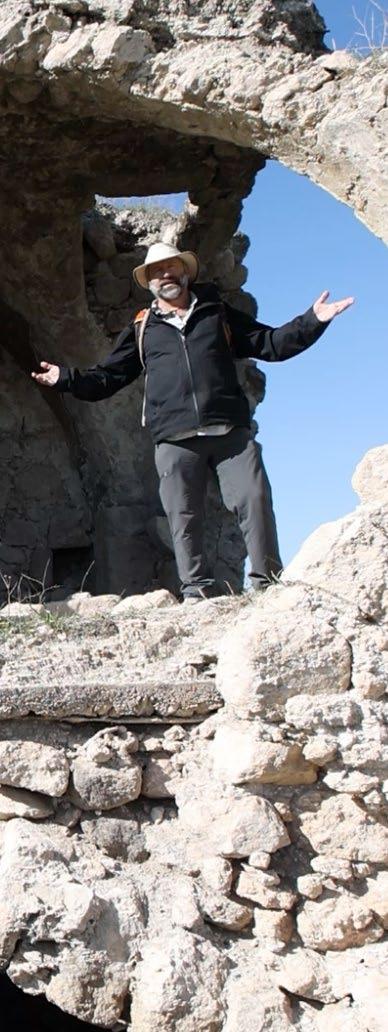
CHELSEA CLINTON IN CONVERSATION WITH ABIGAIL POGREBIN
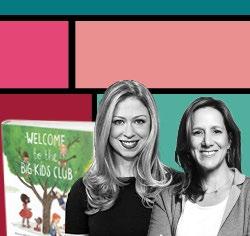
FEB 13 | In Person
The author of Welcome to the Big Kids Club, an essential guide for kids welcoming the newest member of their family, sits down with Abigail Pogrebin, author and host of the JCC's long-running What Everyone's Talking About series. Part of the JCC’s Books That Changed My Life Festival, celebrating the transformational role that books play in our lives.
7–8 pm, $30, which includes a signed copy of Welcome to the Big Kids Club
Click here to purchase tickets
TZEDEK B'YACHAD: BUILDING SOCIAL JUSTICE MOVEMENTS IN ISRAEL

FEB 15 | Virtual
The David H. Sonabend Center for Israel
and The Joseph Stern Center for Social Responsibility at the JCC explore two important grassroots movements in Israel, Tzedek Centers and Standing Together. Tzedek Centers is a national movement of local activist communities, working to promote democracy, equality, and solidarity. Standing Together mobilizes Jewish and Palestinian citizens of Israel in pursuit of peace, equality, and social and climate justice.
noon–1 pm, Pay what you wish
Click here to register
THE CURRENT ISRAELI GOVERNMENT:
THE
GOOD, THE BAD, AND
THE UGLY
MAR 2 | In Person
Martin Indyk, former U.S. Ambassador to Israel, and Moshe Halbertal, Gruss Professor of Law at New York University, will discuss the new government and current affairs in Israel. They will unpack the country's political and social reality, its effect on U.S.-Israel relations, and the general shift to the right and extremism around the world.
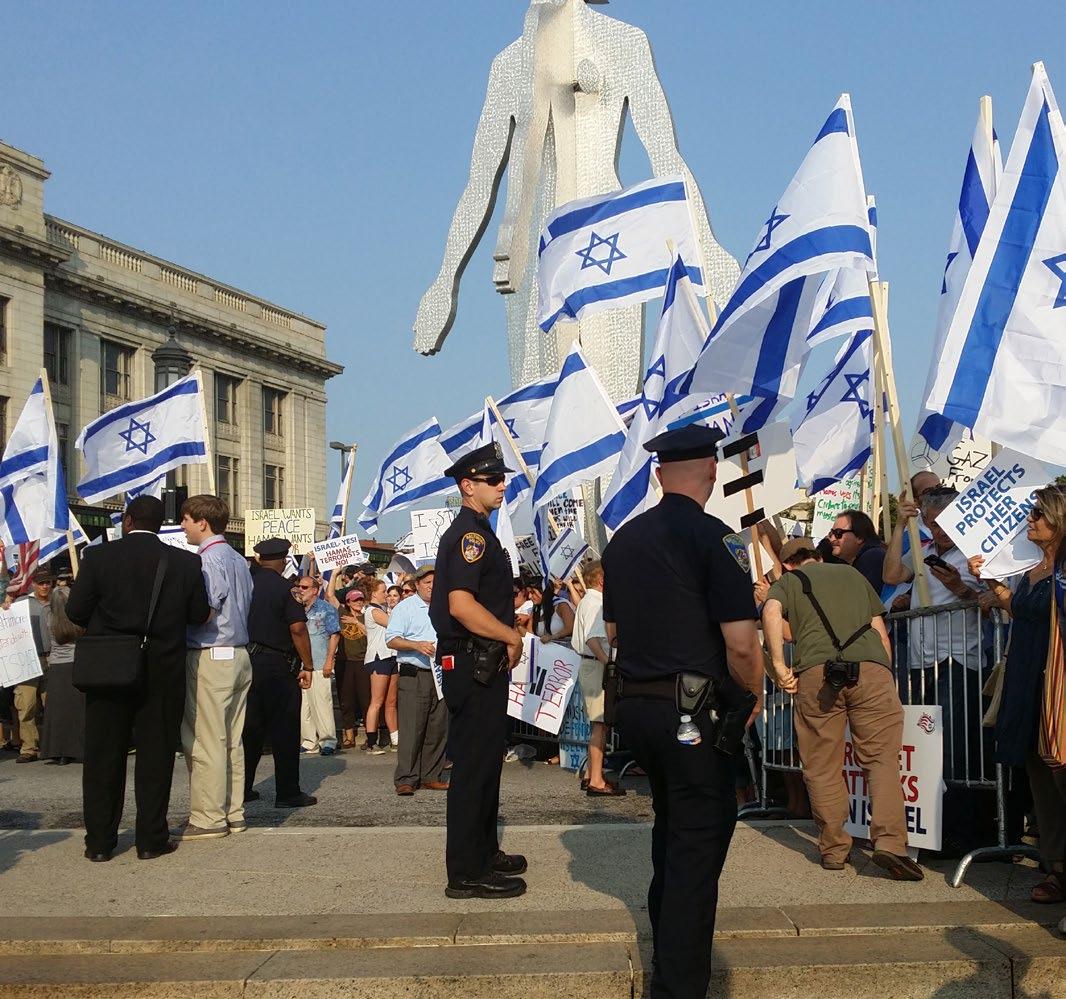
6–7:30 pm, $15
Click here to register
STATE-TO-STATE: FROM STARTUP NATION TO IMPACT NATION
MAR 15 | In Person
Explore Israel and New York’s mutual commitment to safeguarding the planet for future generations, highlighting such partnerships as the New York-Israel Smart Energy Innovation Challenge and other mutual efforts in sustainable development.

6–9 pm, $18/$36
Click here to register
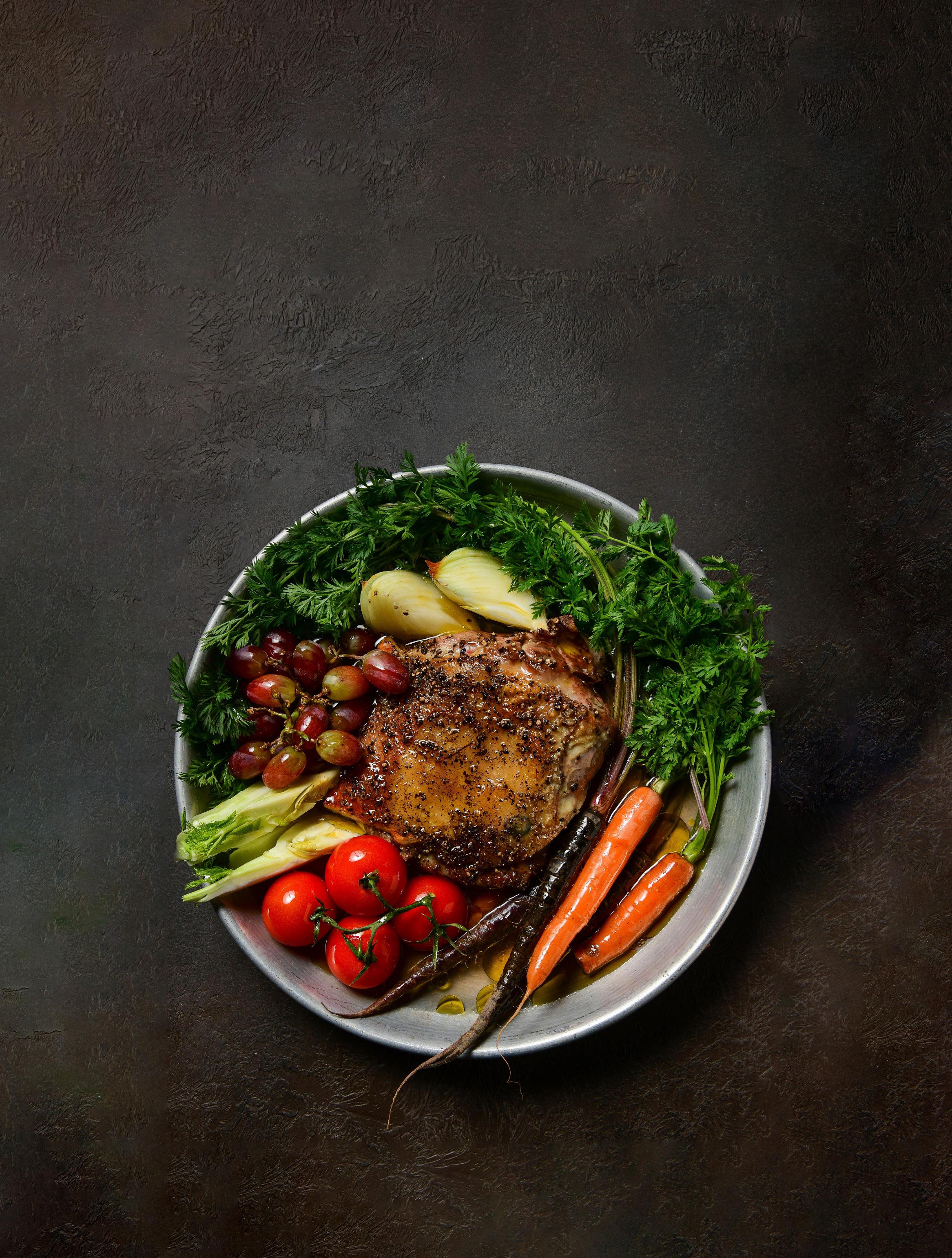
CREDITS
Rabbi Joanna Samuels
Chief Executive Officer
Megan Whitman Chief Program Officer
Deb Kadetsky
Chief Engagement Officer
Udi Urman Director
The David H. Sonabend Center for Israel
Rebecca Grossman Program Director
The David H. Sonabend Center for Israel
Bari Lovi
Director, Leadership Giving
The David H. Sonabend Center for Israel
Shira Kaiserman Verteramo
Managing Director, Marketing
Rebecca Winzenried Editorial Director
Amanda Schechter Director, Program Marketing
Peter Hines
Senior Director, Creative Services
Jessica Epstein
Senior Director, Marketing Operations
Lawrence Quigley
Senior Web Manager
Tzivia Ross Goldfein
Senior Graphic Designer
